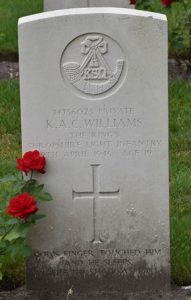Hay-on-Wye, or Hay, is a market town situated in the historic county of Breconshire and is now known as “the town of books”, being the National Book Town of Wales and the site of the annual Hay Festival. The town lies on the south-east bank of the river Wye and is within the north-easternmost tip of the Brecon Beacons National Park, just north of the Black Mountains and is just within the Welsh side of the border with Herefordshire. The adjacent village of Cusop lies on the English side of the Dulas Brook and lies within the county of Herefordshire. The men of the town who fell during both World Wars are commemorated on the Hay and Cusop War Memorial, which is situated at Castle Lane, in Hay-on-Wye. There are also separate memorials inside the churches at Cusop and Hay-on-Wye.
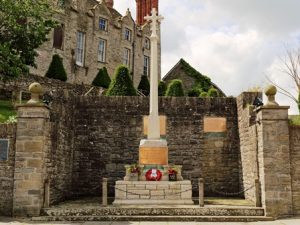
The Great War, 1914-1918
The Honourable Bernard Michael Bailey, Midshipman, Royal Navy. Bernard was born in London on 17 January 1899, the youngest son of Joseph Henry Russell Bailey, Lord Glanusk, and his wife, Edith Elma Bailey (nee Sergison), of Glanusk Park, Breconshire. He was an enthusiastic member of the Boy Scouts as a young man. Bernard joined the Royal Navy in January 1912 and was sent to the Royal Naval College at Dartmouth for training, qualifying as a Midshipman in August 1914. At the outbreak of war, he was posted aboard the Diadem-class armoured cruiser, HMS Argonaut. The cruiser was part of the 9th Cruiser Squadron, operating in the Atlantic and was stationed off Cape Finisterre from August 1914 to July 1915, when she was converted into a Hospital Ship. Bernard was then transferred aboard the Minotaur-class armoured cruiser HMS Defence. Defence had been built at Pembroke Dockyard, and launched on 24 April 1907, and was attached to the 1st Cruiser Squadron of the Grand Fleet as its flagship, under the command of Rear-Admiral Sir Robert Arbuthnot. Following reports that the German High Seas Fleet had put to sea in May 1916, the Grand Fleet steamed into the North Sea to locate the Germans. The First Cruiser Squadron formed the starboard flank of the cruiser screen, ahead of the main body of the Grand Fleet, with Defence to the right of the centre of the line. At 17:47 on 31 May 1916 Defence and HMS Warrior, the leading two ships of the squadron, spotted some German ships and opened fire. Shortly afterwards, they spotted the disabled German light cruiser SMS Wiesbaden and closed to engage, however both ships were spotted by the German battlecruiser SMS Derfflinger and four other battleships, which opened fire upon Defence and Warrior. Defence was hit in the magazine which exploded and sent her to the bottom of the North Sea, with all her crew of some 900 men. Bernard was 17 years old when he was killed in the sinking of Defence and is commemorated on the Plymouth Naval Memorial, Devon. His brother, Gerald Sergison Bailey, had been killed in France the previous year, whilst their uncle, John Lancelot Bailey, died whilst serving in India with the Brecknocks in 1918. Their eldest brother, Wilfred Russell Bailey, was awarded the Distinguished Service Order during the war. The boy’s father, Lord Glanusk, had served during the Boer War of 1899-1902, and was appointed Commanding officer of the 3rd SWB during the Great War, whilst another uncle, William Bailey, took over command of the Welsh Horse Yeomanry from Lord Kensington.
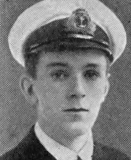
The Honourable Gerald Sergison Bailey, Second Lieutenant, Grenadier Guards. Gerald was born in London on 22 November 1893, the second son of Joseph Henry Russell Bailey, Lord Glanusk, and his wife, Edith Elma Bailey (nee Sergison), of Glanusk Park, Breconshire. He was an enthusiastic member of the Boy Scouts as a young man. Gerald was educated at Eton College and the Agricultural College at Cirencester, before beginning work for R. H. March, chartered accountant at the Cardiff Docks. He then proceeded to British East Africa to work at his father’s estate there. Following the outbreak of the war he returned to England and was commissioned as Second Lieutenant into his father’s old regiment, the Grenadier Guards. Upon embarking for France on 20 April 1915, Gerald was posted to the 2nd Battalion, Grenadier Guards, which his elder brother Wilfred was already serving as adjutant with. The battalion was attached to the 4th (Guards) Brigade, 2nd Division and was in billets at Bethune where Gerald arrived. The battalion moved back into the front line at Givenchy on 23 April, giving Gerald his first taste of trench life and continued a prolonged spell in the line over the coming weeks. By the time the Battle of Festubert opened on 15 May 1915 the 2nd Grenadier Guards had been relieved and were in reserve in billets at Le Casan and on the following day moved forward, to join the fray. The Battle of Festubert raged until 25 May, when it was called off due to heavy casualties and lack of progress. Another routine period of trench warfare then ensued over the coming months. On 4 August 1915 the 2nd Grenadier Guards relieved the Irish Guards to begin another tour in the Givenchy trenches. The Prince of Wales visited the battalion in the trenches on the following day. Gerald was killed in action by a German hand grenade, or bomb, whilst in the trenches here on 10 August 1915. The 22-year-old was buried in Guards Cemetery, Windy Corner, Cuinchy, France. His brother, Bernard Michael Bailey, was killed at the Battle of Jutland the following year, whilst their uncle, John Lancelot Bailey, died whilst serving in India with the Brecknocks in 1918. Their eldest brother, Wilfred Russell Bailey, was awarded the Distinguished Service Order during the war. The boy’s father, Lord Glanusk, had served during the Boer War of 1899-1902, and was appointed Commanding officer of the 3rd SWB during the Great War, whilst another uncle, William Bailey, took over command of the Welsh Horse Yeomanry from Lord Kensington.
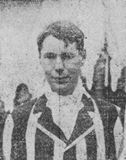
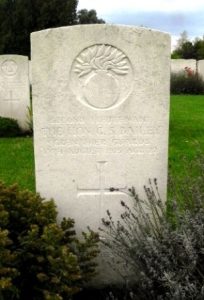
The Honourable John Lancelot Bailey, Captain, South Wales Borderers. John was born at Glanusk on 2 December 1878, the son of Joseph Russell Bailey, Lord Glanusk, and his wife, Mary Anne Jane Bailey (nee Lucas), of Hay Castle, Hereford and of Glanusk Park. He was educated at Eton and Cambridge and in 1903 married Vivien Dora Carey, of Guernsey. He lived with his wife in Guernsey, where their two daughters and a son were born over the coming years. John was commissioned as Second Lieutenant into the Brecknockshire Battalion, South Wales Borderers soon after the outbreak of war. The battalion was attached to the Welsh Division and moved to Pembroke Dock upon mobilisation. It was then withdrawn from the Division and on 29 October 1914 sailed from Southampton for Bombay, where the battalion transhipped and sailed for Aden, arriving on 16 December 1914. The battalion endured a torrid time in the heat of Aden, infamously losing several men to heatstroke. In August 1915 the battalion moved to India on garrison duties and remained there for the duration of the war. John took ill just weeks before the Armistice and died of influenza in hospital at Mhow on 26 October 1918. The 39-year-old was buried in Mhow Military Cemetery, and is commemorated on the Kirkee 1914-1918 Memorial, India. John is not commemorated on the original Llangattock war memorial but is commemorated on the recently erected Crickhowell and District War Memorial. His nephews, Bernard and Gerald Bailey, the two sons of his eldest brother, Lord Glanusk, who were killed during the war.
Horatio Harold Roberts Baker, Lance Corporal, 372, Australian Infantry. Horatio, known as Harold, was born in 1888, the son of Joseph Baker and Susannah Baker (nee Roberts), of Hay. His mother died when he was just four years old, and his father remarried to Annie Elizabeth Smith in 1894. Harold was educated at Hay Council School and at Hampton Grammar School. He emigrated to Australia in 1911 and set up home at Numurkah in Australia, where he found work as a clerk for a Tailor’s shop. Harold enlisted at Shepparton, Victoria into the 7th Battalion, Australian Infantry on 18 August 1914. The battalion was raised by Lieutenant Colonel H. E. “Pompey” Elliott within a fortnight of the declaration of war in August 1914 and embarked just two months later as part of the 2nd Brigade, 1st Australian Division. After a brief stop in Albany, Western Australia, the battalion proceeded to Egypt, arriving on 2 December and began its training in earnest from the Australian Camp at Mena, near the Great Pyramids. The battalion took part in the ANZAC landing at Gallipoli on 25 April 1915, as part of the second wave and was thrown into terrible fighting over the coming days. Ten days after the landing, the 2nd Brigade was transferred from ANZAC to Cape Helles to help in the attack on the village of Krithia. The attack captured little ground but cost the brigade almost a third of its strength. Harold was badly wounded during the attack on Krithia and was evacuated to No. 11 Casualty Clearing Station, where he died of his wounds on 10 May 1915. The 28-year-old was buried in Lancashire Landing Cemetery, Gallipoli. His stepbrother, Lewis Baker, was killed at Ypres in 1917.
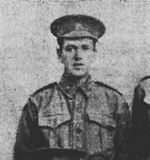
Lewis Westcott Smith Baker, Driver, W/2939, Royal Field Artillery. Lewis was born on 19 November 1895, the son of Joseph Baker and Annie Elizabeth Baker (nee Smith), of Hay. He served his apprentice as a grocer with his father, before gaining work in the office of the Gurnos Colliery and resided with Mr Page, at Alltygrug Road, Ystalyfera. Lewis enlisted at Swansea into the 38th (Welsh) Division, Royal Field Artillery and was posted to D/119th Brigade, landing in France on 24 December 1915. The division was initiated into trench warfare in the Fleurbaix sector and held various sections of the line down towards Cuinchy before marching south to the Somme in June 1916 to take part in the assault on the staunchly defended Mametz Wood. Following heavy losses to the division during the capture of the wood, the division was moved north and took up positions north of Ypres, along the Boesinghe Canal, which it remained in for the coming twelve months. Lewis was killed in action here on 20 June 1917, aged 22. He is buried in grave I.P.28. in Railway Dugouts Burial Ground (Transport Farm), Belgium. Lewis is also commemorated on the Hay War Memorial. His brother, Harold Baker, was killed at Gallipoli in 1915 whilst serving with the AIF.
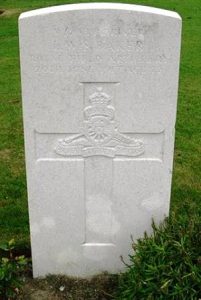
Edward Hibbert Binney, Captain, Sherwood Foresters (Notts and Derby Regiment). Edward was born in Wolverhampton on 21 July 1896, the son of the Reverend John Edward Herbert Binney and Beatrice Elizabeth Lichtenstein Binney (nee Almon). He was the grandson of the Bishop of Nova Scotia. Edward was educated at Mr. Mason’s school at Rottingdean before entering Winchester College in January 1910 and was an enthusiastic athlete, oarsman and cricketer, as well as being a member of the school Photographic Society. Upon leaving Winchester in the summer of 1914, he entered Sandhurst and upon passing out in November 1914, gained a commission as Second Lieutenant into the 1st Battalion Sherwood Foresters. Edward embarked for France on 25 January 1915 to join the battalion, which was in Flanders attached to 24 Brigade, 8th Division. The division was holding the Richebourg Sector when Edward arrived. He joined B Company upon his arrival on 2 February 1915 and three days later entered the trenches for the first time. The 8th Division was moved out of the line shortly afterwards to prepare for the forthcoming Battle of Neuve Chapelle. The battle commenced on 10 March, behind a heavy artillery barrage, and the 1st Sherwood Foresters moved into position during the day ready to launch its own attack on the following morning. As 11 March dawned, the Sherwood Foresters began to advance through an orchard, before launching its assault upon the German lines near Neuve Chapelle. The battalion suffered severe casualties during the assault, even losing its CO, whilst Edward was wounded in the head. He was evacuated by stretcher bearers from the battalion, before eventually making his way to hospital in England, but had lost an eye due to his wounds. By the summer of 1916 he had returned to duty. He joined as A.D.C. to General Braithwaite’s staff, but when the 62nd Division was ordered to France, he was told he was unfit for front-line service, so joined the 3rd (Reserve) Battalion, Sherwood Foresters as Adjutant, becoming promoted to Captain. He fell ill on 7 October 1917, and was diagnosed as suffering from meningitis, and sadly died four days later, on 11 October 1917. The 21-year-old was buried in St. Chad’s Churchyard, Wybunbury, Cheshire.
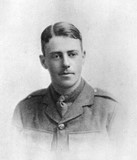
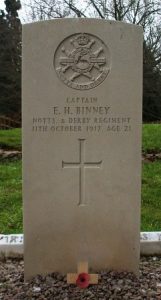
Reginald Charles Bowden, Second Lieutenant, King’s Own (Royal Lancaster Regiment). Reginald was born in 1896, the son of Charles Frederick Bowden, one of the principal officials on the Buenos Ayres and Pacific Railway, and his wife Caroline Sarah Bowden (nee Jones), of 4082, Calle Navarro, Villa Devoto, Buenos Ayres, Argentina. Reginald was educated at the University of Manchester before serving an apprenticeship at the Vulcan Foundry in Newton-le-Willows. He enlisted into the army soon after the outbreak of war, gaining a commission as Second Lieutenant into the 8th Battalion, King’s Own (Royal Lancashire Regiment). The battalion had formed at Lancaster in October 1914, before moving to Codford to join 76 Brigade, 25th Division. The division wintered at Boscombe then in May 1915 moved to Odiham, Aldershot to complete its training before landing in France on 27 September 1915 and taking up positions in the Ploegsteert Sector, for trench initiation. Just over two weeks later, 76 Brigade transferred to the 3rd Division, before moving to billets at Eecke. The 3rd Division was holding the line at St. Eloi, near Ypres and upon joining the division from Eecke, the 8th King’s Own moved into positions at Spanbroekmolen. The Division saw heavy fighting during the Actions of the Bluff in February 1916, when the Germans exploded a series of underground mines beneath the British positions. The 8th King’s Own was in the rest area training when the Germans attacked, and on 15 February stood to, ready to return to the battle zone. On 1 March the battalion marched back into the trenches and on 2 March launched a counterattack against the Germans. Reginald was badly wounded by shrapnel during the assault and was evacuated to the Hospital at Remi Sidings, where he died of his wounds the following day, 3 March 1916. The 19-year-old was buried in Lijssenthoek Military Cemetery, Belgium.
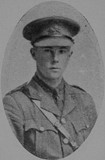
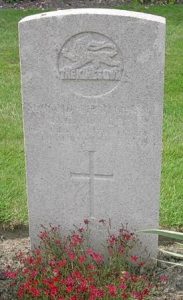
James Albert Bromley, MM, Private, 8994, King’s Shropshire Light Infantry. James was born in Hereford in 1890, the son of Thomas Bromley and Elizabeth Bromley (nee Williams). He left home as a young man to enlist at Hereford into the King’s Shropshire Light Infantry and by the time that war was declared, was serving in Ireland with the 1st Battalion, King’s Shropshire Light Infantry. The battalion left Ireland and arrived at Cambridge on 20 August, attached to 16 Brigade, 6th Division. On 10 September 1914 the division landed at St. Nazaire and entrained to reinforce the thinly stretched BEF at the Aisne, northeast of Paris. The BEF moved north to Flanders soon afterwards and the 6th Division took over positions around Bois Grenier. The 1st KSLI set its HQ up at Flamingerie Ferme, where it spent its first Christmas in France. The division moved to Armentieres on 3 January, where it spent almost five months before moving into the Ypres Salient, taking over the Canal Bank sector at Boesinghe at the beginning of June, and moving to Potijze a week later. The division then saw its first major action during the Action of Hooge that month, enduring a horrific few weeks. The division remained at Ypres for another year before being relieved on 1 August 1916 and transferred south to the Somme sector, to join the great offensive there. James was wounded soon afterwards, whilst carrying messages across No Man’s Land, during an act of gallantry which earned him the award of the Military Medal and was evacuated back to Britain. Whilst home on sick leave he met and married a war widow, Clara Jane Beddows, the daughter of John and Margaret Haywood, of Hay, who had lost her first husband, Walter, when he had been killed in France in August 1915. Upon regaining his fitness, James was posted to the 8th Battalion, King’s Shropshire Light Infantry, which was in Salonika attached to 66 Brigade, 22nd Division. James was killed in Salonika just months afterwards, on 31 August 1917. The 27-year-old is buried in Doiran Military Cemetery, Greece. His widow Clara had been left with three children from her first husband, then had another child by James. She remarried again in 1919 and lived until 1960 after surviving her third husband by eight years.
Edward Godfrey Brooks, Corporal, 34929, Manchester Regiment. Edward was born in 1893, the son of Thomas James Brooks and Elizabeth Brooks (nee Davies), of St. Mary’s Villas, Hay. He worked with his father as a house painter prior to becoming a Grocer’s Assistant with Mr Kedward, at Broad Street, Hay, then went to work for a Grocer in Oldham. He was then given a promotion to manage a Grocery in Preston. Despite initially being rejected twice, Edward enlisted at Manchester into the Manchester Regiment in the spring of 1916. He was posted to France soon afterwards to join the 11th Battalion, Manchester Regiment, which had transferred from Egypt to France in July 1916 attached to 34 Brigade, 11th Division, following service at Gallipoli. The division saw its first major action in France during the Battle of Flers-Courcelette in September 1916 and remained on the Somme for the winter. The division spent Christmas in trenches on the Ancre, in terrible conditions, with its infantry battalions taking turns rotating for duty in the front line. The 11th Manchester’s were relived from a routine tour in the front line on the morning of 11 January 1917 and moved back into the reserve line, whilst the 5th Dorset’s launched an attack against the German trenches facing them. Edward was killed when the positions held by the 11th Manchester’s were heavily shelled by the Germans just prior to a counterattack. The 23-year-old has no known grave and is commemorated on the Thiepval Memorial, France.
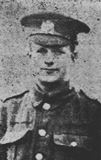
Frederick Thomas Budden, Private, 245167, Royal Warwickshire Regiment. Frederick was born in 1899, the son of Frank Gardiner Budden, a former Grenadier Guardsman, and Sarah Annie Budden (nee Lloyd), of 10, Castle Street, Hay. His father had come to Hay to run the Wine Vaults Public House and had founded the Welsh Border Lodge of the R.A.O.B. in the town. His father died in 1904, and his mother sent Frederick away to be educated at Druids Heath R.A.O.B. Orphanage at Aldridge, near Walsall. Frederick enlisted into the East Yorkshire Regiment at Bridlington soon after the outbreak of war. He was then posted to the 7th Battalion, Sherwood Foresters (Notts & Derby Regiment), before being drafted to France and posted to the 16th Battalion, Royal Warwickshire Regiment. The battalion was attached to 95 Brigade, 32nd Division and had returned to France from Italy in April 1918, to bolster the thinly stretched British lines following the launching of the German Somme offensive of 21 March 1918. The division moved to the southern part of the Somme sector in time to take part in the latter stages of the Battle of Amiens. It remained here over the coming months, then when the war turned after the epic Australian success at Villers Bretonneux on 8 August, the 32nd Division took part in the great offensive which was launched on 21 August, which began the advance towards the Hindenburg Line. The division launched its attack from its positions near Couin, towards Achiet-le-Petit and over the coming days captured Bihucourt and Irles before crossing the Bapaume to Arras Road and continuing the advance towards Beugny, the scene of ferocious fighting in March 1918. Frederick was killed in action when the 16th Warwickshire’s assaulted Beugny on 2 September 1918. The 19-year-old was buried in Bailleul Road East Cemetery, St. Laurent-Blangy, France.
Eric Percival St. George Cartwright, Second Lieutenant, Leinster Regiment. Eric was born at Market Harborough on 5 September 1896, the son of Arthur Cartwright and Ellen Mabel Cartwright (nee Heywood). His father worked for HM Inspector of Schools, so the family moved several times over the coming years, boarding at Barmouth by 1901 and then to the Knoll, Colwall, Malvern by 1911, before settling at Rothbury, Cusop. Eric was educated with his brother Ronald at Bilton Grange, Rugby and Charterhouse, where he joined the Officer Training Corps. Eric was commissioned into the 4th (Reserve) Leinster Regiment in September 1915 and was posted to the Curragh to join the battalion. Eric was drafted to France on 9 February 1916 and was attached to the 45th Company, Machine Gun Corps. The company was attached to 45 Brigade, 15th (Scottish) Division and was still in the Loos Sector when Eric arrived. Eric went home on leave on 19 June for the last time and re-joined the battalion at Vermelles on 27 June. The division was relieved at the end of July and began to move south to the Somme, to join the great offensive, taking over positions near Contalmaison. The division then took part in the Battle of Pozieres, fighting alongside the Australians during a horrific action. Eric was killed by a German sniper at dawn at Contalmaison on 12 August 1916. The 19-year-old was buried in Becourt Military Cemetery, Becordel Becourt, France. One of his fellow officers wrote home to his parents: ‘He directed the fire of the gun in the most splendid manner in the attack on the night of the 12th and did great work. No-one in the particular part of the line worked harder that night through the attack and many a man had his wounds bandaged by Eric. He was hit by a sniper as it was beginning to get light and died instantaneously. He was buried the following and the ceremony was attended by the whole Company.’ His brother, Ronald, was killed in France in 1918, whilst his other brother, Kenneth, survived the war.
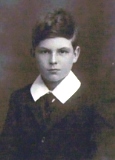
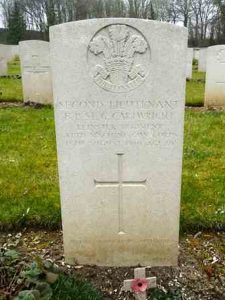
Ronald William St. George Cartwright, Second Lieutenant, Royal Flying Corps. Ronald was born at Market Harborough on 29 March 1894, the son of Arthur Cartwright and Ellen Mabel Cartwright (nee Heywood). His father worked for HM Inspector of Schools, so the family moved several times over the coming years, boarding at Barmouth by 1901 and then to the Knoll, Colwall, Malvern by 1911, before settling at Rothbury, Cusop. Ronald was educated with his brother Eric at Bilton Grange, Rugby and Charterhouse. Upon leaving school, Ronald took up farming, and emigrated to British Columbia early in 1914 where he worked as a rancher. He enlisted at Victoria, British Columbia into the Canadian Expeditionary Force on 1 November 1914 and embarked for England with the 16th Battalion, Canadian Infantry on 23 February 1915. After just over two months in France he was taken ill and collapsed on 1 June 1915 whilst in the trenches at Givenchy and was admitted to No 2 General Hospital at Le Havre, originally being diagnosed as suffering from gastritis, he was found to be suffering from appendicitis and had an operation there to remove his appendix. Ronald was then sent back to England and was posted to Shorncliffe Camp, joining the 30th Battalion, Canadian Infantry. He was discharged from the Canadian Infantry as medically unfit following a medical board on 2 September 1915, due to a nervous disposition, which today is known to be PTSD, or shellshock. Ronald continued to fight his condition over the coming months, before being deemed fit enough to re-enlist, and was commissioned as Second Lieutenant in the Royal Flying Corps. He trained as an Observer before being drafted back out to France to join 16 Squadron, Royal Flying Corps, which was based at St. Omer under the command of Hugh Dowding. On 26 February 1918, just prior to the formation of the Royal Air Force, Ronald was flying on a photographic reconnaissance mission aboard an RE8, Serial A3531 when it was attacked by five enemy aircraft. The pilot, Lieutenant Duthie, turned his aircraft back towards British lines but was intercepted and shot down some 2,000 yards west of Mericourt, killing Ronald. The 23-year-old was buried in Aubigny Communal Cemetery Extension, France. His brother, Eric, had been killed on the Somme in 1916, whilst their other brother, Kenneth, survived the war.
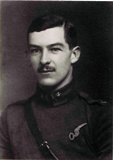
Arthur Frederick Clark, Corporal, 207399, Worcestershire Regiment. Arthur was born in 1881, the son of George Clarke and Annie Eliza Clarke (nee Pope), of 1 The Grove, Westbury, Sherborne, Dorset. He worked as a gardener after leaving school, and by 1911 was living at The Bothy, Sezincote, Moreton in Marsh, where he worked as a gardener on the famous Indian inspired estate. Arthur married Laura Margarette Jones, of Middleton House, Cusop on 2 January 1915 and just over nine months later their only child, Arthur George Clarke, was born. Arthur enlisted at Sherborne into the Dorsetshire Yeomanry, then upon being drafted to France to join the 1st Battalion, Dorsetshire Regiment, was transferred to the 2nd Battalion, Worcestershire Regiment, which was attached to 100 Brigade, 33rd Division. Arthur probably joined the battalion as it was rebuilding following the divisions efforts in stemming the German offensive on the Lys in April 1918, where the division had put up a stout defence around Neuve Eglise. The division then took part in the First Battle of Kemmel, and recapture of Ridge Wood. The division remained in the Ypres Salient over the summer then in August moved south to join the great Allied offensive which had been launched on 21 August 1918. The division moved to the Lechelles area before joining the advance, working in conjunction with the 38th (Welsh) Division and began forcing its way towards the Hindenburg Line. On 28 September the 2nd Worcester’s took up assembly positions in preparation for another advance on the following morning, then at zero hour on 29 September 1918 the men of the battalion climbed out of their trenches to assault the German outer Hindenburg defences. Arthur was last seen alive going over the top that morning but was shot and killed during the advance. The 37-year-old is buried in Pigeon Ravine Cemetery, Épehy, France.
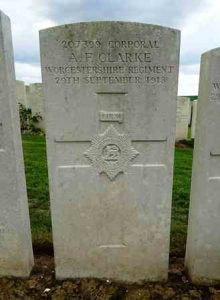
Charles Crompton, Sergeant, 1688, South Wales Borderers. Charles was born in 1892, the son of Charles Crompton and Mary Jane Crompton (nee Whitcombe), of Oak Cottage, Brecon Road, Hay. He worked as a fireman in Brecon prior to the war, and was a member of the Brecknockshire Battalion, South Wales Borderers, having enlisted in 1913. The battalion was attached to the Welsh Division and moved to Pembroke Dock upon mobilisation. It was then withdrawn from the Division and on 29 October 1914 sailed from Southampton for Bombay, where the battalion transhipped and sailed for Aden, arriving on 16 December 1914. The climate in Aden was fearsome, with scorching heat during the day, and with little to do, the men spent much of their free time playing football. By June 1915 the Turks had become overconfident due to the lack of any incursions by the British into Yemen and moved forward to reoccupy fortifications at Sheikh Saad. They then began to shell the island of Perim, so the Allied troops in Aden were mobilised into the Aden Movable Company and ordered to prepare to join with local troops. 400 men of the Brecknocks were allocated to the column, the remainder stayed in Aden. A small artillery column was built up to join it and on 3 July the force moved out to Sheikh Othman. Many men collapsed on the march, which was carried out during the full heat of the day, but by 7.30 pm the column had completed its six-mile advance. Charles was among thirteen men who died of heatstroke during the following day, 4 July 1915, during an even longer march. The 23-year-old has no known grave and is commemorated on the Heliopolis (Aden) Memorial, Egypt.
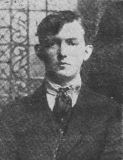
Frederick James Davies, Private, 10674, South Wales Borderers. Frederick was born in 1894, the son of John Davies and Agnes Davies (nee Hodges), of 5, Garibaldi Terrace, Hay. Worked as a railway porter prior to the war and by 1911 was lodging at 2, Railway Terrace, Cwmbargoed, Dowlais. Frederick then enlisted at Brecon into the South Wales Borderers and by the time war erupted was serving with the 2nd Battalion, South Wales Borderers. The battalion was in Tientsin, China at the outbreak of war and took part in a famous operation with the Japanese against the German held port of Tsingtao on 23 September. On 4 December the battalion embarked at Hong Kong and landed at Plymouth on 12 January 1915, entraining for Rugby to join 87 Brigade, 29th Division. Frederick then returned home on leave to visit his family, for what turned out to be the final time. On 17 March 1915 the battalion sailed from Avonmouth with the Division, arriving at Alexandria on 29 March, before moving to Mudros. On 25 April 1915 the Division landed at Cape Helles, Gallipoli, as part of the original landing force which had been despatched to try and seize the Dardanelles Straits and force Turkey out of the war. The invasion forces failed to break the Turkish defences and the campaign became bogged down. Frederick was badly wounded at Gallipoli on 20 August, having a leg shattered by a bullet. He was evacuated by Hospital Ship to the 19th General Hospital at Alexandria where his leg was amputated, but he died soon afterwards, on 13 September 1915. The 21-year-old was buried in Alexandria (Chatby) Military & War Memorial Cemetery, Egypt.
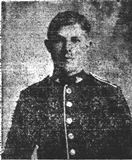
Herbert Edward Gordon Davies, Sergeant, 12006, South Wales Borderers. Herbert was born in 1885, the son of Alfred Davies and Elizabeth Davies (nee Williams), of Dulas Terrace, Cusop. He married Lily Kathleen Badham on 12 September 1912 and the couple set up home at 4, Dulas Terrace. Herbert worked as a fitter and was a member of the Brecknockshire Battalion, South Wales Borderers prior to the war. Herbert was drafted to France in 1916 to join the 1st Battalion, South Wales Borderers. The battalion was attached to 3 Brigade, 1st Division and moved from Loos to the Somme sector at the beginning of July 1916, taking part in the heavy fighting for Bazentin Ridge. The division saw further heavy fighting on the flank of the Australian Corps during the Battle of Pozieres, then saw further fighting during the Battles of Flers-Courcelette and Morval. After wintering on the Somme, the division followed the German withdrawal to the Hindenburg Line in early 1917, before being briefed for an operation on the Flanders Coast and moved there during the summer of 1917. The operation, Operation Hush, was a planned offensive along the coast if the Passchendaele offensive was successful but was called off when the troops at Passchendaele became bogged down in the mud and the 1st Division was instead transferred to Ypres in October 1917, to join the great push for Passchendaele Ridge. The Division took up positions near Valour Farm, on the lower edge of the ridge, by 9 November and prepared to launch an assault on the following morning. The objectives were a series of ruined farms which had been fortified by the Germans and at dawn on 10 November 1917 the Division launched its assault. The men arose from the trenches and began to advance through thick mud, but the men got caught up in their own artillery barrage. Herbert was killed in action that day. The 32-year-old has no known grave and is commemorated on the Tyne Cot Memorial, Belgium.
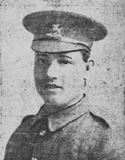
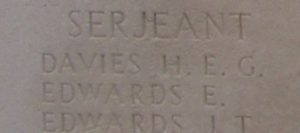
Ifor Garfield Davies, Second Lieutenant, Duke of Edinburgh’s (Wiltshire Regiment). Ifor was the son of David John Davies and Magdalene Davies (nee Moses), of The Green Dragon, High Street, Brecon. He was educated at Mount Street School and then at the Brecon County School, before becoming a clerk at Barclays Bank at Hay. Ifor enlisted into the 26th (Stockbroker’s) Battalion, Royal Fusiliers soon after the outbreak of war and served in France with the battalion from 27 May 1916 until 12 August 1917, when he returned to Britain for officer training. Ifor was commissioned as Second Lieutenant into the Duke of Edinburgh’s (Wiltshire Regiment) on 26 March 1918 and was posted to France, joining the 2nd Battalion, Wiltshire Regiment at Auchy au Bois on 22 July 1918. The battalion was by then attached to 58 Brigade, 19th (Western) Division and was still rebuilding following heavy losses suffered during the Third Battle of the Aisne from 27 May until being relieved on 6 June. The battalion embussed for Chocques on 6 August and on the following day took over positions in the front-line northeast of Hinges, for the first time in two months. Ifor was killed in action by a shell-burst here just two days later, on 8 August 1918. The 24-year-old was buried in Le Vertannoy British Cemetery, Hinges, France. Ifor is not commemorated on the Hay and Cusop war memorial, but at Brecon.

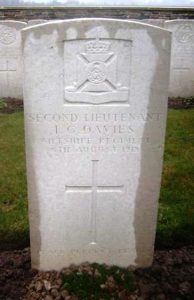
George Duggan, Private, 54915, Royal Welsh Fusiliers. George was born in Hereford in 1889. He was raised by his grandparents, Thomas and Ann Duggan at Wyatt, Marden. He married Florence Lizzie Borrow in 1913 and the couple came to live at Hay after George had gained a position as gardener for Mr. Graystone at Moor, Hay. George enlisted into the army at Hereford and was posted to a reserve battalion of the Monmouthshire Regiment. Upon completing his training, he was drafted to France in the summer of 1916, and was posted to the 1st Battalion, Royal Welsh Fusiliers, which was attached to 22 Brigade, 7th Division. In the summer of 1916, the Division was on the Somme, and took part in the Battle of Albert, where it captured Mametz, one of the few successes of 1 July 1916. The division then fought at the Battle of Bazentin, and the Attacks on High Wood, playing a successful part in the ‘dawn attack’, and men from the division became the first troops to advance into High Wood. The Division then took part in the Battle of Delville Wood, and the Battle of Guillemont, before spending the winter on the Ancre. In March 1917 the division followed up the German Retreat to the Hindenburg Line, and took part in Flanking Operations Round Bullecourt, alongside the Australians. George was wounded at Bullecourt and returned home to Britain for treatment. Upon his recovery, he came home on leave in July, before returning to France to re-join the 1st Royal Welsh Fusiliers, which was still in the Arras sector. Later in the year the Division moved to Ypres, and fought at the Battle of the Polygon Wood, suffering terrible casualties. The battalion then took part in the Battle of Broodeseinde before being relieved from Polygon Wood on the night of 10 October and moved to billets at Moolenacker, where it remained until 22 October when the men began to march back towards the front, to re-join the offensive, taking over positions at Bodmin Copse and Hedge Street on the night of 25 October to take part in an attack towards Gheluvelt. George was killed in action during the following day, 26 October 1917, when the battalion sent out patrols across the devastated No Mans Land. The 27-year-old has no known grave and is commemorated on the Tyne Cot Memorial, Belgium.
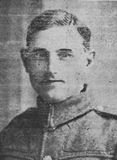
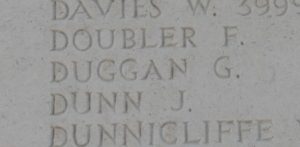
Alfred Edwards East, Private, 2637, Middlesex Regiment. Alfred was born in 1895, the son of Alfred East and Esther Mary East (nee Edwards), of Lansdowne House, Cusop. His father came to Cusop to work as a manager in a Grocery, but by 1911 had moved his family after starting his own business at Victoria Stores, Birchington-on-Sea, in Kent. Alfred was educated at Stanley House School, Margate before entering London University. He enlisted into the 2/10th Battalion, Middlesex Regiment at Stamford Brook on 22 September 1914. The battalion formed at Stamford Brook that month, moving to Staines to join 201 Brigade, 67th Division, then on 24 April 1915 joined the Welsh Border Brigade, Welsh Division at Cambridge. In May 1915 the division moved to Bedford where it became numbered to the 53rd (Welsh) Division. On 19 July 1915 the entire Division sailed from Devonport for Imbros and on 9 August 1915 landed at Suvla Bay. The infantry moved off the beaches across the Salt Lake, under shellfire, into the scrub covered Chocolate Hill, but due to a lack of maps and no knowledge of the terrain, many of the units became disorientated, and the situation became chaotic. After the fighting died down, the winter rolled in, and the men first had to endure torrential downpours, which flooded the trenches, before the snow hit, and many men began falling ill in the terrible conditions. Alfred became one of many casualties of this terrible winter at Gallipoli when he died of exposure there on 1 December 1915. The 20-year-old is buried in Lala Baba Cemetery, Gallipoli. Alfred is not commemorated locally.
William Edwards, Private, 266612, Welsh Regiment. William was born at Grosmont in 1897, the son of James Edwards and Mary Jane Edwards. The family moved to Bear Street, Hay prior to the war. William enlisted into the army at some time in 1916 and after completing his training was drafted to France, where he was posted to the 15th Battalion, Welsh Regiment. The battalion, known as the Carmarthen Pals battalion, was attached to 114 Brigade, 38th (Welsh) Division and had been in France since 2 December 1915, seeing its first major action during the divisions assault on Mametz Wood on 7 July 1916. The initial attack failed, and it was three days later, on 10 July, that a fresh attack was mounted. After two days of heavy hand to hand fighting within the wood, the Germans withdrew, and the battered Welshmen moved via Hébuterne to Boesinghe, on the Yser Canal, where it remained until launching its attack on Pilckem Ridge on 31 July 1917. The 15th Welsh remained in the line, and also took part in the Battle of Langemarck, before the entire Division was moved to positions near Armentieres over the winter. After the Germans launched their offensive on the Somme on 21 March 1918, the Division was moved back to the Somme, and took up positions north of Albert, around Aveluy Wood at the end of March 1918, relieving the battered 2nd and 47th Divisions. A series of small-scale assaults were carried out during the coming weeks, aimed at taking the high ground on Bouzincourt Ridge, which afforded a view over the Ancre Valley towards Thiepval Ridge. The 15th Welsh took part in an assault on Aveluy Wood on 10 May, which resulted in heavy losses being suffered due to a miscalculation by the supporting Divisional Artillery which fired on its own troops. The battalion then had a brief rest before returning to the line on 14 May to begin a routine tour in the trenches. William was killed in action during the relief that day, 14 May 1918. The 20-year-old is buried in Harponville Communal Cemetery, France.
Richard Davies Garnons Williams, Lieutenant-Colonel, Royal Fusiliers (City of London Regiment). Richard was born at Llowes, Radnorshire on 15 June 1856, the son of Reverend Garnons Williams and Catherine Francis Williams (nee Hort). His father later became Vicar of St. John’s, Brecon. Richard was educated at Magdalen College School, Oxford and at Trinity College, Cambridge. Richard became known as a talented rugby player and upon leaving Cambridge, was accepted into the Royal Military Academy at Sandhurst, where he played rugby for the Sandhurst Rugby Team. Richard completed his officer training in 1876 and was commissioned as a sub-lieutenant into the 38th Regiment of Foot, before transferring to the 7th Regiment of Foot the following year. He continued to play rugby and during his first years in the army played for Brecon and for Newport RFC, where he became selected for Wales for its first ever rugby international against England in 1881. Richard married Alice Jessie Bircham at Chelsea on 8 January 1885, and the couple had one child, a daughter, Barbara, who later married Captain Hume Buckley Roderick of the Welsh Guards. By February 1885 Richard had been promoted to captain, and his unit had been renamed the Royal Fusiliers (City of London Regiment). Upon retiring from the army on 4 May 1892, Richard was commissioned as major in the 1st (Brecknockshire) Volunteer Battalion, South Wales Borderers, before being appointed Brigade Major for the South Wales Brigade of the Volunteer Force and became a well-known figure in Brecon. By the time that Richard resigned his commission in 1906 he had been promoted to Lieutenant-Colonel. He re-joined the Army shortly after the outbreak of war and re-joined his original regiment after being posted to the 12th Battalion, Royal Fusiliers. He was then given temporary command of the Brecknock Battalion, South Wales Borderers for a while, before assuming command of the 12th Battalion, Royal Fusiliers. He joined the battalion at Pirbright, where it was attached to 73 Brigade, 24th Division, and on 1 September 1915 took his battalion to France. The battalion disembarked at Boulogne on the following day, before entraining for Montreuil and the men then marched to billets at Embry. Over the coming days the battalion trained and carried out practise attacks, as the 24th Division had received orders to move to the Loos sector. On 25 September the British launched a large-scale assault upon the German defences around the town of Loos but suffered terrible casualties in doing so. As a result, the inexperienced 24th Division was thrown into the fight, and moved to Vermelles later that day. The division moved into position that night and on the following morning, 26 September 1915, launched an assault on the German lines north-east of Vermelles. Richard was posted as wounded and missing during the early stages of the attack. It appears that he had been shot in the head and killed whilst trying to withdraw his men. No trace of the 59-year-old was ever found, so he is commemorated on the Loos Memorial to the missing, France. Richard was the eldest of thirteen former Welsh international rugby players to be killed during the war. He is not commemorated on the Brecon war memorial, but at nearby Hay-on-Wye. His son-in-law, Hume Buckley Roderick, was also killed during the war.
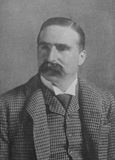
James Gough, Private, 200510, South Wales Borderers. James was born in Oldham, Lancashire in about 1881, the son of Elizabeth Gough. They had moved to Newport Street, Hay by 1908, where James worked as a timber haulier and Elizabeth was a widow. James enlisted into the Brecknockshire Battalion, South Wales Borderers on 3 April 1908, stating that he was currently a member of the 1st Volunteer Battalion, South Wales Borderers. The battalion was an old Militia unit, which had been replaced by the Brecknocks following the formation of the Territorial Army in April 1908. James attended the annual TA summer camp without fail over the coming years, at: Brecon; Porthcawl; Aberystwyth; Haverfordwest; Hereford; and Haverfordwest again prior to the war. James married Annie Rose Rosser in 1914 and the couple had two sons, Henry, born in Hay, and William, born in Peterchurch. Following the outbreak of war the 1st Brecknockshire Battalion mobilised in Brecon, before moving to Pembroke Dock as part of the Welsh Division. James remained in Brecon, joining the newly raised 2nd Brecknockshire Battalion, so did not embark for Aden with the Brecknocks in 1915. The 1st Brecknocks endured a torrid time in the heat of Aden, losing several men to heatstroke. In August 1915 the battalion moved to India on garrison duties. James was then drafted out to India to join the battalion at Mhow, where it remained for the duration of the war. James took ill less than a month prior to the Armistice and died of influenza there on 24 October 1918. The 37-year-old is buried in Mhow New Cemetery, India.
Henry Norman Grant, Second Lieutenant, Lancashire Fusiliers. Henry was born at Hay-on-Wye on 3 December 1892, the son of Henry Richard Grant and Jane Victoria Grant (nee Hughes), of 6, Castle Street. He entered Christ College in 1907 and played golf and rugby for the school. Upon leaving school, Henry went to work in Hereford as a Bank Clerk at the Hereford Branch of the United Counties Bank. He enlisted into the Public Schools Battalion, Royal Fusiliers soon after the outbreak of war, before being selected for officer training at the Royal Military Academy at Sandhurst. Henry was then commissioned as Second Lieutenant into the Lancashire Fusiliers. He was drafted to France on 4 May 1916 and joined the 1st Battalion, Lancashire Fusiliers, which was attached to 86 Brigade, 29th Division. The Division had recently arrived in France following service in Gallipoli and Egypt and had taken over a section of the front line near Beaumont Hamel, on the northern edge of the Somme sector. Henry joined A Company of the battalion, as machine-gun officer. The Division had an arduous time here too over the coming months, before taking part in a suicidal assault on 1 July 1916, on the opening day of the Somme offensive. The 1st Lancashire Fusiliers advanced down the famed Sunken Lane towards the assembly point before launching its assault some minutes after the blowing of the great underground mine on Hawthorne Ridge. Henry was among some 508 casualties suffered by his battalion alone that morning. He was initially posted as missing, but the body of the 23-year-old was later found on the battlefield, and he was buried in Redan Ridge Cemetery No.2, Beaumont-Hamel, France.
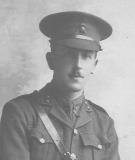
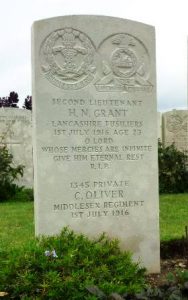
Arthur Allan Griffiths, Lance Corporal, 1319, Welsh Guards. Arthur was the son of Jeremiah and Mary Griffiths, of 3, Bridge Villa, Credenhill, Hereford. He had served with the Grenadier Guards prior to 1900 when he enlisted into the Gloucester Regiment. He embarked for South Africa with the regiment in 1900, and saw action during the Boer War, then served in India until returning to England again in 1908. In 1912 he left the army to join the Breconshire Constabulary and served as a Policeman at Brecon then at Builth. Arthur married Martha Fox on 9 October 1911, then the couple moved to Hay, following him being posted to Hay Police Station and their three sons were born there over the coming years. He enlisted at Hay into the 1st Battalion, Welsh Guards during the spring of 1915. The Regiment was raised by Royal Warrant of 26 February 1915, at White City, before landing at Le Havre on 18 August 1915, becoming attached to 3rd Guards Brigade, Guards Division. The Division saw its first major action during the Battle of Loos on 25 September 1915, remaining in the area during the coming months, where they also fought in the subsequent Action of Hohenzollern Redoubt. In July 1916 the Division moved to the Somme, where they fought at the Battle of Flers-Courcelette, and then at the Battle of Morval, capturing Lesboeufs Village. They remained here for the winter and followed up the German withdrawal to the Hindenburg Line the following spring. Arthur was killed in action by a shell along with two other men while carrying out wiring repairs in No Man’s Land on 5 March 1917. The 33-year-old is buried in Sailly-Saillisel British Cemetery, France. One of his three sons, Arthur John Griffiths, was killed whilst flying aboard a Vickers Wellington in 1945.
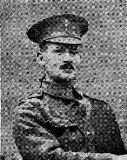
John Havard, Private, 6341, Canadian Infantry. John was born on 9 August 1884, the son of Thomas Havard and Mary Havard (nee Evans), of 33, Lion Street, Hay. He emigrated to Canada as a young man, embarking aboard the SS Empress of Ireland on 23 September 1910 to join his cousin, Arthur Havard, who had moved there some years earlier, and found work as a decorator. John and Arthur enlisted at Valcartier into the Canadian Expeditionary Force on 17 September 1914, and were posted to the 1st Battalion, Canadian Infantry. John embarked with the battalion at Quebec aboard the SS Laurentic for England on 25 September 1914 and disembarked at Devonport on 14 October, before moving to Bustard Camp, near Amesbury, joining the 1st Canadian Brigade, 1st Canadian Division. The division completed its training on Salisbury Plain, before embarking for France at Avonmouth on 8 February 1915 and disembarked at St. Nazaire, before entraining for Flanders, for trench initiation in the Fleurbaix sector. On the night of 1 March 1915, the 1st Battalion, Canadian Infantry moved into the trenches here for the first time, relieving the 1st South Staffs, to begin a routine tour in the front line. The division moved to the Ypres Salient in April and faced its first real test during the defence of St. Julien, which began on 22 April, following the first German gas attack of the war upon the French Colonial troops holding the Gravenstafel sector, which heralded the opening of the Second Battle of Ypres. The French fled in terror, so the Canadians were pushed forward to plug the gap in the line, before retiring to secondary positions on 26 April, which the Canadians held until 4 May. The Canadians then moved back to Flanders and two weeks later took part in a diversionary attack whilst the British launched the Battle of Festubert. On 13 June the 1st Battalion, CEF exchanged its Canadian made Ross Rifles for the more reliable British SMLE, then on 15 June 1915 launched an assault from their positions east of Givenchy against a strongly defended German position. John was killed in action during the attack that day, being shot dead by a hidden soldier when storming the German trench. The 30-year-old has no known grave and is commemorated on the Vimy Memorial, France.
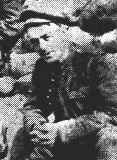
Bertram Hincks, Second Lieutenant, King’s Royal Rifle Corps. Bertram was born on 1 May 1890, the son of Doctor Thomas Samuel Hawkesford Hincks and Emily Hincks (nee Fairbanks), of Cartrefle, Hay. He entered Christ College in 1904 and was a gifted sportsman, playing rugby, hockey and cricket for the school. Upon leaving in 1908 he began work as a bank clerk in London, but after four years decided to emigrate to Canada to try something more exciting. Bertram embarked aboard the SS Lake Erie on 10 October 1912 and after disembarking in Montreal, settled down at Victoria, Vancouver Island, where he became a land agent and farmer, together with one of his elder brothers who ran his own fruit farm. On 23 September 1914 Bertram enlisted at Valcartier into the Canadian Expeditionary Force and was posted to the 16th Battalion, Canadian Infantry. Bertram embarked at Quebec with the battalion aboard the SS Andania on 7 October 1914, disembarking in England. The battalion entrained for Salisbury Plain where it became attached to the 3rd Brigade, 1st Canadian Division and embarked for France in February 1915. The Division moved to reserve positions at Hazebrouck before relieving the 7th Division in the Fleurbaix sector during the opening days of March. The Canadians moved to the Ypres Salient in April and faced its first real test during the defence of St. Julien beginning on 22 April, following the launch of the first German gas attack upon French Colonial Troops. Bertram took part in the terrible fighting which followed, then fought with the Canadians during the Battle of Festubert. He was promoted to Corporal by the end of the year, then took part in the terrible fighting at Mount Sorrel in June 1916, before gaining a commission as Second Lieutenant into the 3rd Battalion, South Wales Borderers on 6 July 1916 and was sent to Pembroke College, Cambridge to undergo an Officer Training course. He was then posted back to France, where he was posted to the 10th Battalion, King’s Royal Rifle Corps, which was attached to 59 Brigade, 20th (Light) Division. Bertram joined the battalion at Mericourt L’Abbe on 9 October 1916, together with a draft of 50 other ranks. The battalion had suffered heavy casualties during fighting around Guillemont and Gueudecourt during the preceding weeks and was rebuilding prior to going back into the line. The battalion remained out of the line for several more weeks, receiving drafts and carrying out training schemes before marching from Mericourt back into the firing line on 8 December. The 10th KRRC took over a section of the line between Lesboeufs and Morval by 10 December to begin a routine tour in the trenches. Conditions were abysmal, the weather was cold and wet, and the trenches were a quagmire. It was a very sickly battalion that was relieved four days later, marching back to bivouacs at Carnoy. On 17 December the battalion moved back into the line to begin another tour. At 19.30 on 18 December 1916 Bertram was shot dead by a German sniper near Morval. The 26-year-old was buried behind the front line by his men, but his grave was located during the post war battlefield clearances, and he was re-interred in Delville Wood Cemetery, Longueval, France. His nephews, John Hawkesford Hincks and Thomas Stewart Hincks, both died in World War Two.

Alfred Robert Holbrow, Private, M2/045707, Army Service Corps. Alfred was born in 1879, the son of James Holbrow and Emma Holbrow (nee Watkins), of Nant-y-Scallon, Llanigon. By 1881 the family were living at Tregoyd Mansion, where James worked as a coachman to Viscount Hereford and Emma was a domestic servant. By 1891 the family had moved to 26, Castle Street in Hay, where James was an inn keeper. Albert followed in his father’s footsteps and by 1901, was working as the third coachman to the Earl of Powys and was living at Walcot Stables, at Walcot Hall, Lydbury North, Shropshire. He then became chauffeur to Captain J. H. Conway Lloyd of Dinas House, Brecon. Alfred married Jessie Crump Thruxton, Hereford on 20 July 1909 and the couple set up home at Trefedw, Dinas. Albert enlisted into the Army Service Corps as a Driver in January 1915 and was posted to the Motor Transport Depot at Grove Park, in London. He became ill at the beginning of February 1915 and was taken to the Royal Herbert Hospital at Woolwich, where he died on 8 February 1915. The 35-year-old was buried with full military honours in Greenwich Cemetery, London. His widow, Jessie, never remarried and passed away in Yorkshire in 1970.
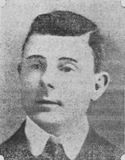
Frederick Holmes, Private, 267472, Monmouthshire Regiment. Frederick was born at Newent, Gloucestershire on 24 September 1880, the son of William Holmes and Jane Holmes (nee Rudd). The family moved to Fern Cottage, Holmer, Herefordshire by 1881 after William had gained work there as a farm labourer. Frederick began working as an engine cleaner for the Great Western Railway at Hereford on 14 March 1898 but left of his own accord two months later and began working as a carter at Mill House Farm, Much Cowarne. He married Sarah Jane Hodges in 1902 and the couple set up home at 38, Belmont Road, Hereford. In 1912 Frederick began working for Messrs R Williams and Sons, Ltd, and the family moved to The Gardens, Heol-y-Dwr, Hay. Frederick enlisted at Hay into the Brecknockshire Battalion, South Wales Borderers on 2 September 1914 and was posted to the Depot at Brecon, to join the 2/1st Brecknocks. The battalion left Brecon for Dale, in Pembrokeshire in April 1915 to join the Milford Haven garrison, then at the end of 1915 moved to Bedford to join the 68th (2nd Welsh) Division. On 30 July 1916 Frederick was drafted to France, joining the Infantry Base Depot, before being posted to the 2nd Battalion, Monmouthshire Regiment, joining the battalion at Brandhoek, in the Ypres Salient. The 2nd Monmouth’s was the Pioneer Battalion to the 29th Division, which had suffered terrible casualties during the opening day of the Battle of the Somme on 1 July 1916 and had moved to Ypres to refit. The Division held the line here over the coming weeks as it rebuilt its strength and the 2nd Monmouth’s worked hard on improving trenches and digging new communications trenches. The battalion then worked on the Menin Road, erecting elephant shelters, then on 4 October the Division was relieved and entrained south for the Somme once more, moving to Trônes Wood, before joining the latter stages of the Somme offensive. The Division wintered on the Somme, with the 2nd Monmouth’s working on road repairs around Montauban, then at Ginchy, Flers and Morval. The 2nd Monmouth’s moved into reserve at the end of December and moved to Fourdrinoy, where the men trained in infantry assault manoeuvres. In December 1916, Frederick contracted influenza and was hospitalised for almost three months before returning to duty on 13 April 1917. By this time, the 29th Division was in the Arras sector, and the 2nd Monmouth’s were at work on road repairs around Tilloy, in readiness for the forthcoming Battle of Arras. Three days later the battalion was ordered to dig assembly trenches in front of the German held village of Monchy-le-Preux, which the division had been tasked with capturing on the opening day of the forthcoming battle. The Battle of Arras opened at dawn on 23 April 1917. Frederick was among a party of men of the 2nd Monmouth’s sent forward to dig communication trenches to link up the old front line with German positions which had been captured during the morning but was killed soon after moving forward to carry out this work. The 30-year-old was originally buried on the battlefield near Monchy, but in January 1920 his grave was exhumed, and he was re-interred in Vis-En-Artois British Cemetery, Haucourt, France.
George Clarence Hope, Private, 43874, Welsh Regiment. George was born in 1895, the son of William Hope and Elizabeth Matilda Hope (nee Walker), of Lion Street, Hay. George trained as a carpenter prior to the war. He enlisted at Hay into the Brecknockshire Battalion, South Wales Borderers, and was posted to the 2/1st Brecknocks. The battalion left Brecon for Dale, in Pembrokeshire in April 1915 to join the Milford Haven garrison, then at the end of 1915 moved to Bedford to join the 68th (2nd Welsh) Division. George was then posted to the 18th Battalion, Welsh Regiment. The battalion was raised in January 1915 as a Bantam Battalion, made up of men of below average height, and initially went to Porthcawl attached to the 43rd (Welsh) Division. During July 1915 the battalion moved to Prees Heath to join 119 Brigade, 40th (Bantam) Division and landed in France with the Division in June 1916. The Division moved to positions around Lillers before taking over the North Maroc Sector, near Loos, for trench initiation and once acclimatised was left to hold the sector itself over the coming months. The infantry battalions of the Division then began the usual routines of rotating for duty in the trenches: normally four days in the front line; four in support and four in reserve. Late in 1916 the Division moved south to the Somme, and fought at the Battle of the Ancre, before remaining in the sector over the winter. On 30 December 1916 the 18th Welsh were in billets near Suzanne, in the Somme Valley, when a German shell hit a nearby French ammunition dump, which exploded, killing nineteen men and injuring another eight. George was among the dead. The 21-year-old was originally buried with his comrades in Priez Farm Cemetery. Unfortunately, the cemetery was destroyed by shellfire later in the war, so all of the men known to have been buried there are commemorated on Special Memorials, or Kipling headstones, in Guards’ Cemetery, Combles, France.

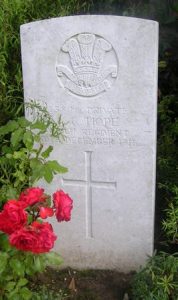
George Jenkins, Lance Corporal, 1370, South Wales Borderers. George was born at Stretton Sugwas, Herefordshire in 1890, the son of Arthur Jenkins and Isabella Jenkins (nee Vale, formerly Stephens). The family had moved to Heol-y-Dwr, Hay by 1901 and Arthur was working as a woodman and timber feller. George worked as a gardener for Lady Glanusk as a young man and enlisted at Hay into the 1st Volunteer Battalion, South Wales Borderers on 5 April 1907. On 3 April 1908 the battalion became the Brecknockshire Battalion, South Wales Borderers, following the formation of the Territorial Army. George attended the annual TA Summer Camp at Porthcawl that year, but then left Hay in 1910 after gaining work as a gardener for Mary Brogden, at Iscoed, Ferryside, Carmarthenshire. Iscoed was the former home of the Welsh war hero, General Sir Thomas Picton, a contentious figure who had been killed at the Battle of Waterloo. George returned to Hay as soon as war was declared and re-joined the Brecknockshire Battalion, South Wales Borderers. The battalion was attached to the Welsh Division and moved to Pembroke Dock upon mobilisation. It was then withdrawn from the Division and on 29 October 1914 sailed from Southampton for Bombay, where the battalion transhipped and sailed for Aden, arriving on 16 December 1914. The climate in Aden was fearsome, with scorching heat during the day, and with little to do, the men spent much of their free time playing football. By June 1915 the Turks had become overconfident due to the lack of any incursions by the British into Yemen and moved forward to reoccupy fortifications at Sheikh Saad. They then began to shell the island of Perim, so the Allied troops in Aden were mobilised into the Aden Movable Company and ordered to prepare to join with local troops. 400 men of the Brecknocks were allocated to the column, the remainder stayed in Aden. A small artillery column was built up to join it and on 3 July the force moved out to Sheikh Othman. Many men collapsed on the march, which was carried out during the full heat of the day, but by 7.30 pm the column had completed its six-mile advance. George was among thirteen men who died of heatstroke during the following day, 4 July 1915, during an even longer march. The 25-year-old has no known grave and is commemorated on the Heliopolis (Aden) Memorial, Egypt.
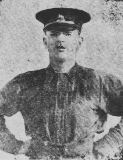
Charles Thomas Roger Jones, Lance Corporal, 26651, Grenadier Guards. Charles was born in 1897, the son of Arthur Jones and Isabella Thirza Jones (nee Williams, formerly Stephens), of the Nelson Inn, Hay. His father died in 1898, so his mother, who had already been widowed, had to raise her family alone. Charles worked as a clerk for the Midland Railway Company at Hay prior to enlisting at Hereford into the Grenadier Guards in September 1916. He came home on furlough in February 1917 prior to embarking for France to join the 4th Battalion, Grenadier Guards. The battalion was attached to the 3rd Guards Brigade, Guards Division, alongside the Welsh Guards, and was still on the Somme, near Priez Farm, when Charles joined its ranks. During March 1917 the Guards Division took part in the advance caused by the German Retreat to the Hindenburg Line. Later that year it moved north to Ypres and fought at the Battle of the Pilckem Ridge, the opening phase of the Passchendaele offensive. The Guards Division saw further fighting at Ypres, during the later stages of the offensive, before being moved south, taking part in the Battle of Cambrai and by the end of November was in the thick of the action there, suffering heavy casualties. Charles returned home on leave in February 1918, and re-joined his battalion at Écoivres, where the Guards Division was still holding part of the line in front of Arras. At dawn on 21 March 1918 the Germans launched the first stage of their spring offensive, along the stretch of Western Front running south from Croisilles to La Fère, and the Guards Division became caught up in the terrible fighting which ensued. After several days of terrible fighting, the Guards were withdrawn, moving to Villers Brulin to rest, before being moved north to Flanders to help stem the second phase of the German offensive which had been launched on the Lys on 9 April. Charles was killed in action near Borre just after this move, on 13 April 1918. The 20-year-old has no known grave and is commemorated on the Ploegsteert Memorial, Belgium. His stepbrother, Fred Hugh John Stephens, died in Egypt in 1919, whilst a nephew, Kenneth George Charles Davies, was killed in North Africa in 1942.
Charles James Lewis, Private, 1775, South Wales Borderers. Charles was born on 17 July 1896, the son of Joseph Lewis and Mary Ann Lewis (nee Morris), of The Old Post Office, Llyswen. By 1911 Charles had left home and was working as a farm servant for Christopher and Catherine John at Ffrwd Uchaf Farm, Cefn Coed. Charles enlisted at Hay into the Brecknockshire Battalion, South Wales Borderers soon after the outbreak of war. The battalion was attached to the Welsh Division and moved to Pembroke Dock upon mobilisation. It was then withdrawn from the Division and on 29 October 1914 sailed from Southampton for Bombay, where the battalion transhipped and sailed for Aden, arriving on 16 December 1914. The climate in Aden was fearsome, with scorching heat during the day, and with little to do, the men spent much of their free time playing football. By June 1915 the Turks had become overconfident due to the lack of any incursions by the British into Yemen and moved forward to reoccupy fortifications at Sheikh Saad. They then began to shell the island of Perim, so the Allied troops in Aden were mobilised into the Aden Movable Company and ordered to prepare to join with local troops. 400 men of the Brecknocks were allocated to the column, the remainder stayed in Aden. A small artillery column was built up to join it and on 3 July the force moved out to Sheikh Othman. Many men collapsed on the march, which was carried out during the full heat of the day, but by 7.30 pm the column had completed its six-mile advance. Charles was among thirteen men who died of heatstroke during the following day, 4 July 1915, during an even longer march. The 19-year-old has no known grave and is commemorated on the Heliopolis (Aden) Memorial, Egypt. His brother, Joseph Thomas Lewis, had been killed at Gallipoli on 25 April 1915. The brothers had met briefly in Aden, when the 2nd SWB were on their way to England from China.
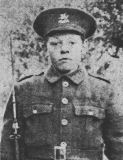
Joseph Thomas Lewis, Private, 10640, South Wales Borderers. Joseph, known as Thomas, was born in 1893, the son of Joseph Lewis and Mary Ann Lewis (nee Morris), of The Old Post Office, Llyswen. He left home as a young man and by 1911 was at Brecon Barracks serving with the South Wales Borderers. Thomas then embarked for China with the 2nd Battalion, South Wales Borderers prior to the war. The battalion was in Tientsin at the outbreak of war and took part in a famous operation with the Japanese against the German held port of Tsingtao on 23 September. On 4 December the battalion embarked at Hong Kong and landed at Plymouth on 12 January 1915, entraining for Rugby to join 87 Brigade, 29th Division. On 17 March 1915 the battalion sailed from Avonmouth with the Division, arriving at Alexandria on 29 March, before moving to Mudros. On 25 April 1915 the Division landed at Cape Helles, Gallipoli, as part of the original landing force which had been despatched to try and seize the Dardanelles Straits and force Turkey out of the war. Thomas was killed in action during the landing of the 2nd SWB on 25 April 1915. The 23-year-old has no known grave and is commemorated on the Helles Memorial, Gallipoli. His brother, Charles James Lewis, died at Aden on 4 July 1915. The brothers had met briefly in Aden, when the 2nd SWB were on their way to England from China.
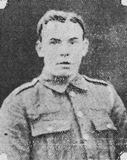
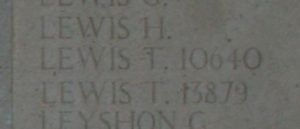
Harry Lloyd, Private, 1478, South Wales Borderers. Harry was born in 1894, the son of Elizabeth Lloyd, of 16, Lion Street, Hay. He worked as a baker at Hay prior to becoming a collier in South Wales. Harry returned to Hay soon after the outbreak of war as he was a member of the Brecknockshire Battalion, South Wales Borderers. The battalion was attached to the Welsh Division and moved to Pembroke Dock upon mobilisation. It was then withdrawn from the Division and on 29 October 1914 sailed from Southampton for Bombay, where the battalion transhipped and sailed for Aden, arriving on 16 December 1914. The climate in Aden was fearsome, with scorching heat during the day, and with little to do, the men spent much of their free time playing football. By June 1915 the Turks had become overconfident due to the lack of any incursions by the British into Yemen and moved forward to reoccupy fortifications at Sheikh Saad. They then began to shell the island of Perim, so the Allied troops in Aden were mobilised into the Aden Movable Company and ordered to prepare to join with local troops. 400 men of the Brecknocks were allocated to the column, the remainder stayed in Aden. A small artillery column was built up to join it and on 3 July the force moved out to Sheikh Othman. Many men collapsed on the march, which was carried out during the full heat of the day, but by 7.30 pm the column had completed its six-mile advance. Harry was among thirteen men who died of heatstroke during the following day, 4 July 1915, during an even longer march. The 21-year-old has no known grave and is commemorated on the Heliopolis (Aden) Memorial, Egypt.
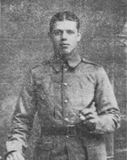
Albert Magness, Private, 241200, Welsh Regiment. Albert was born in 1886, the son of William Magness and Charlotte Magness (nee Price), of Hay. He married Mary Ann South in 1913 and the couple initially lived at Rhymney, where their first child was born, before moving back to 14, Church Terrace, Hay in 1914. Albert enlisted at Bargoed into the 5th (Reserve) Battalion, Welsh Regiment. He was drafted to France in the summer of 1916, joining the 1/6th Battalion, Welsh Regiment, which was the Pioneer Battalion to the 1st Division. The division fought throughout the Somme offensive that year and after wintering on the Somme followed the German retreat to the Hindenburg Line in March 1917. The division was then briefed for a potential operation on the Flanders Coast, Operation Hush, and moved there during the summer of 1917, taking over positions near Coxyde. The offensive was to take place if the Allies managed to break-through the German defences on Passchendaele Ridge, following the launching of the Third Battle of Ypres on 31 July 1917, but the offensive became stalled in the Flanders mud, so the 1st Division was sent to Ypres, to take part in the terrible fighting for Passchendaele. The Division took up positions near Valour Farm, on the lower edge of the ridge, by 9 November and prepared to launch an assault on the following morning. The objectives were a series of ruined farms which had been fortified by the Germans and at dawn on 10 November 1917 the Division launched its assault. The men arose from the trenches and began to advance through thick mud, but the men got caught up in their own artillery barrage and heavy casualties were suffered. The offensive drew to a close soon afterwards and the fighting moved away to the Cambrai Sector. The 1st Division wintered in the Ypres Salient, and in the beginning of March 1918 moved to the Éstaires area, where it was hit hard following the launching of the German Spring Offensive along the Lys Valley on 9 April 1918. Albert was killed in action as the Allies were being driven back, on 18 April 1918. The 31-year-old is buried in Gorre British and Indian Cemetery, France.
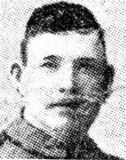
John Lacey Morgan, Private, 267501, Monmouthshire Regiment. John was born in 1896, the son of William Morgan and Isabella Morgan (nee Price), of Tuplin’s Row, Lion Street, Hay. John worked as a timber feller prior to the war. He enlisted at Hay into the Brecknockshire Battalion, South Wales Borderers on 12 March 1914 and attended the Annual TA Summer Camp that year. He was mobilised on 5 August 1914 and was posted to Brecon, where he joined the 2/1st Brecknockshire Battalion, South Wales Borderers the following month. The battalion left Brecon for Dale, in Pembrokeshire in April 1915 to join the Milford Haven garrison, then at the end of 1915 moved to Bedford to join the 68th (2nd Welsh) Division. In November 1916 the battalion was absorbed by the 2/7th Battalion, Royal Welsh Fusiliers at Wrentham, near South Wold, and moved to Benacre Camp, Wrentham. John embarked for France at Southampton on 30 July 1916, joining the Infantry Base Depot at Rouen, and after a spell in hospital suffering from scabies, was posted to the 2nd Battalion, Monmouthshire Regiment, re-joining the battalion at Ypres on 21 September. The 2nd Monmouth’s had originally served as an infantry battalion before being transferred to the 29th Division, becoming the Divisional Pioneer Battalion. The Division had suffered terrible casualties at Beaumont Hamel, during its assault on Y-Ravine on 1 July 1916 and, although severely depleted, the Division remained in the line here over the coming weeks, in trying conditions. On 27 July the Division entrained for Flanders, detraining at Proven before relieving the 6th Division at Ypres. The Division held the line here over the coming weeks as it rebuilt its strength and the 2nd Monmouth’s worked hard on improving trenches and digging new communications trenches. The battalion then worked on the Menin Road, erecting elephant shelters, then on 4 October the Division was relieved and entrained south for the Somme once more, moving to Trônes Wood, before joining the latter stages of the Somme offensive. The Division wintered on the Somme, with the 2nd Monmouth’s working on road repairs around Montauban, then at Ginchy, Flers and Morval. The division moved to the Arras sector the following year and in the Spring of 1917 the Division fought at the Battle of the Scarpe, which was part of the Arras Offensive, seeing heavy fighting around Monchy-le-Preux. The division then moved further north to Ypres, initially to hold the line whilst other units had been withdrawn for specialist training, in readiness for the Third Battle of Ypres, which opened on 31 July 1917. The 29th Division went into reserve whilst the first attacks, the Battle of Pilckem Ridge, took place, then on the night of 14-15 August the moved into the line facing Langemarck, ready to launch another offensive, suffering heavy casualties. The Division then had another period out of the line to rest and refit before taking part in further fighting near Poelcapelle. Early in November 1917 the Division was relieved from the line at Ypres, and moved south to the Bellacourt area, to prepare to take part in the forthcoming Battle of Cambrai. The Division entrained for Péronne on 17 November, marching to a camp four miles out of the town at Haut Allaines, then by midnight on 18 November had reached Fins. On the following day the Division received its battle stores and detailed orders for the forthcoming battle, marching off via Gouzeaucourt to its assembly positions at Marcoing. The assault began at dawn on 20 November, but the Division suffered terrible casualties whilst attacking Masnières, on the Hindenburg Line. After wintering in the Cambrai sector, in January 1918 the 29th Division moved back to Ypres, taking up positions at Passchendaele Ridge again. To the south, the Germans launched the opening phase of their great offensive along the Somme front on 21 March 1918, then on 9 April launched the second phase along the Lys Valley. The 29th Division was relieved by the 41st Division that day and moved out of the line, before being rushed to positions at Les Haies Basses on the evening of 10 April. On the following morning the Division was hit by the Germans and the 29th Division was forced to withdraw, as it was flanked on the left. John was posted as missing during heavy fighting on 12 April 1918. He was later confirmed as having been killed in action on that day, following a letter from the German authorities to the Red Cross and he was buried on the roadside, between Bailleul and Armentieres. No trace of the grave of the 21-year-old was found after the war, so he is commemorated on the Ploegsteert Memorial, Belgium. His parents later moved to 3, Bay Cottage, Kimberley Road, Sketty, in Swansea.
Charles Geoffrey Noel Morris, Lieutenant, Oxfordshire & Buckinghamshire Light Infantry. Charles was born on 19 December 1893, the son of Henry Morris and Elizabeth Morris (nee Gosson), of The School House, Hay. His mother died in 1897, and his father married a fellow schoolteacher, Catherine Eleanor Smith, in 1899. Charles was educated at Hay before being sent to Hereford Cathedral School, then gained a place at Keble College, Oxford, where he intended to study Holy Orders. He left Oxford after gaining a commission as Second Lieutenant into the 7th Battalion, King’s Shropshire Light Infantry on 24 November 1914, then on 28 December transferred to the 9th Battalion, Oxfordshire & Buckinghamshire Light Infantry. Charles was drafted to France on 8 September 1916 and was posted to the 6th Battalion, Oxfordshire & Buckinghamshire Light Infantry, which was attached to 60 Brigade, 20th (Light) Division. Charles joined the battalion at the Citadel Camp, near Fricourt, on the Somme, where it was resting following heavy fighting at Guillemont several days earlier. On 16 September the battalion moved into the front line near Waterlot Farm, west of Trônes Wood, to begin Charles’s first tour in the trenches. The 20th Division then supported a successful assault by the 6th Division on the Quadrilateral position. On 21 September the 6th Ox & Bucks LI was relieved and headed back to the Citadel Camp for a rest, then a week later was ordered back into the line, reaching Carnoy Valley on 28 September before taking over reserve positions in Trônes Wood two days later. On the afternoon of 6 October 1916, the battalion moved into the front line, relieving the 6th KSLI, and on the following morning, 7 October 1914, launched a frontal assault upon Rainbow Trench, a strongly defended German position near Morval. Charles was killed in action by shell fragments during the assault that day, in his first major action. The 22-year-old has no known grave and is commemorated on the Thiepval Memorial, France.
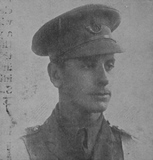
Frederick Phillips Pearson, Corporal, 2881, South Staffordshire Regiment. Frederick was born at Liverpool on 11 May 1880, the son of Edward Pearson and Maria Pearson (nee Phillips). His father moved the family back to his native Whitchurch, Shropshire by 1891. Frederick was educated at the Merchant Taylor’s School at Great Crosby and upon leaving joined the National and Provincial Bank as a clerk. He left his position to enlist into the Volunteer Company, Cheshire Regiment in 1899 and served in South Africa during the Anglo-Boer War of 1899-1902. Upon his return to Britain, he resumed his position as a cashier for the National and Provincial Bank, at Wolverhampton. In May 1914 Frederick left Wolverhampton to take up a position at the banks branch at Hay. Frederick left Hay to enlist into the 1/6th Battalion, South Staffordshire Regiment at Wolverhampton in September 1914. The battalion was a Territorial Army unit which mobilised at the Drill Hall in Wolverhampton at the outbreak of war as part of the Staffordshire Brigade, North Midland Division. The division moved to the Luton area, then in November 1914 to the Bishops Stortford area, before embarking for France and on 3 March 1915 landed at Le Havre. The division entrained for Flanders, taking over positions in front of Armentieres, where in May 1915 the formation became numbered as 137 Brigade, 46th (North Midland) Division. The division held the line in the Wulverghem sector in the months following its creation, its infantry battalions carrying out the by now usual routines of rotating for duty in the trenches, usually four days in the line, four in reserve and four in support. On 5 July 1915 the 6th South Staffs relieved the 4th Leicester’s in the front line at Zillebeke to begin a routine tour in the trenches. Frederick was killed in action here whilst attempting to rescue two comrades who had been buried by earth flung up from a dud German shell. The gallant bank clerk was digging out his friends, with no thought to his own safety, when another shell burst and a piece of shrapnel hit him in the head, killing him instantly. The 35-year-old was originally buried on the battlefield near Zillebeke, but his grave was lost during ensuing fighting in the area. His grave was found during battlefield clearances in January 1929 and Frederick was identified by his personal effects. He was then interred in Sanctuary Wood Cemetery, Belgium.
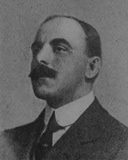
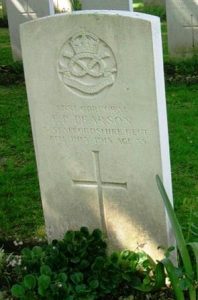
John Charles Powell, Private, 12047, South Wales Borderers. John was born in 1879, the son of John and Jane Powell, of Hay, Herefordshire. By 1911 he was lodging at North Street, in Winchcombe, Gloucester, where he was working as a Gents Outfitter. John married Mary Jeanie Ratcliffe, a dressmaker, on 10 January 1914, before the couple went to live at his mother’s native Talgarth, setting up home there at Red House. John enlisted into the 3rd Battalion, South Wales Borderers in the spring of 1915. He was then posted to the 12th Battalion, South Wales Borderers. The battalion was raised at Newport by the Welsh National Executive Committee in March 1915 as a bantam Battalion, then in July 1915 moved to Prees Heath to join the Welsh Bantam Brigade. During September 1915 the Brigade moved to Aldershot and became 119 Brigade, in the 40th (Bantam) Division. In December 1915 the Division moved to Blackdown to complete its training before embarking for France and landing at Le Havre on 2 June 1916. The Division moved to positions around Lillers before taking over the North Maroc Sector, near Loos, for trench initiation and once acclimatised was left to hold the sector itself over the coming months. The infantry battalions of the Division then began the usual routines of rotating for duty in the trenches: normally four days in the front line; four in support and four in reserve. Late in 1916 the Division moved south to the Somme, and fought at the Battle of the Ancre, before remaining in the sector over the winter. In March 1917 the Germans withdrew to their shortened line, called the Hindenburg Line, and the 40th Division was among the units which followed the withdrawal. Later in the year the Division took part in the Battle of Cambrai and launched an attack on Bourlon Wood on 23 November 1917. The attack was carried out by 119 Brigade, led by the 12th SWB and 19th RWF. The 17th Welsh was in support for the initial assault, but was soon ordered to advance, to support the two attacking battalions. Heavy fighting raged within the wood over the coming days, with the 18th Welsh also being thrown forwards into the fight, and the Division suffered terribly. John was wounded during the fighting and was evacuated via the usual chain of Advanced Dressing Station to Casualty Clearing Station, before reaching the base hospital at Abbeville. He died there of his wounds on 8 December 1917. The 38-year-old was buried in Abbeville Communal Cemetery Extension, France. His widow, Mary, married a former soldier, Ernest Kirby, at Talgarth in 1922, but sadly she was widowed again the following year.
James Bernard Price, Private, 201458, South Wales Borderers. James was born at Cheadle, Staffordshire on 17 January 1891, the son of James Price and Sarah Ann Price (nee Wood). The family had moved to Llangrannog, Cardiganshire by 1901, and then moved again to Lion Street, Hay. James worked as a skin buyer and dealer. He enlisted at Hay into the Brecknockshire Battalion, South Wales Borderers on 27 March 1908, but left the battalion after only a years’ service. He married Elizabeth Swan at Hay in 1914, and the couple had three sons over the coming years. James enlisted into the South Wales Borderers at Hay at the end of September 1916 and joined the Depot at Brecon before being posted to the 2/1st Brecknocks. In November 1916 the battalion was absorbed by the 2/7th Battalion, Royal Welsh Fusiliers at Wrentham, near South Wold, and moved to Benacre Camp, Wrentham. He was drafted to France in the summer of 1917, joining the 6th Battalion, South Wales Borderers, which was the Pioneer Battalion to the 25th Division. James probably joined the battalion following its efforts during the Battle of Messines in June 1917. After fighting at Messines, the Division fought at the Pilckem Ridge, before moving south to the Arras Sector, taking up positions around Bullecourt in reserve. Here the Division was used to reinforce the badly depleted British units that were hit in the area by the German Spring Offensive of 21 March 1918. The Division then moved north to Flanders on the night of 30 March, where it took up positions at Ploegsteert again. On 9 April the Germans launched the second phase of their Spring Offensive along the Lys Valley, and the Division was caught up in the terrible fighting which ensued. James was initially posted as missing on 12 April 1918, as the division was being driven back. He was later officially declared as having been killed in action on 15 April 1918, on the day that the 6th SWB was relieved. The 28-year-old has no known grave and is commemorated on the Ploegsteert Memorial, Belgium.
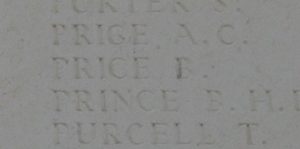
Leonard Price, Saddler, TS/10188, Royal Army Service Corps. Leonard was born in 1888, the son of Joseph Price and Sarah Ann Price (nee Williams), of Walnut Cottage, 34, Lion Street, Hay. Leonard had enlisted into the Brecknockshire Battalion, South Wales Borderers at Hay on 24 April 1908 after already having served with the old 1st Volunteer Battalion, South Wales Borderers, but after a year’s service, left the battalion and by 1911 he was lodging at 147, Eureka Place, Ebbw Vale, where he worked as a Grocers Assistant. He then he became a postman at Newport prior to the war. Leonard enlisted into the Army Service Corps during the summer of 1915 and was posted to the 36th Reserve Battalion, at Morn Hill Camp, Winchester. He married May Sarah Ann Edworthy at Maindee on 19 February 1916, whilst on leave, then returned to Winchester prior for embarking for France, joining the 2nd Cavalry Reserve Park. Leonard must have come home on leave again after this, as his only child, his daughter Moya Gwendolyn Price, was born at Newport in June 1918. The 2nd Cavalry Reserve Park spent the summer of 1918 in the Somme sector, transporting equipment and supplies. Leonard was wounded at Beaucourt by shellfire on 10 August, and was evacuated to the 48th Casualty Clearing Station, where he died of his wounds on the following day, 11 August 1918. The 29-year-old was originally buried in Dury Hospital Military Cemetery, but in December 1927 the graves within the cemetery were exhumed and Leonard was re-interred in Villers-Bretonneux Military Cemetery, Fouilloy, France.
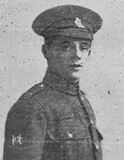
Ivor George Prosser, Private, 201304, South Wales Borderers. Ivor was born in 1887, the son of George Prosser and Caroline Prosser (nee Prosser), of 4, Church Street, Hay. Ivor worked as a domestic gardener prior to the war. He enlisted at Brecon into the 2/1st Brecknockshire Battalion, South Wales Borderers soon after the outbreak of war. The battalion left Brecon for Dale, in Pembrokeshire in April 1915 to join the Milford Haven garrison, then at the end of 1915 moved to Bedford to join the 68th (2nd Welsh) Division. In November 1916 the battalion was absorbed by the 2/7th Battalion, Royal Welsh Fusiliers at Wrentham, near South Wold, and moved to Benacre Camp, Wrentham. Ivor was drafted to France around this time, joining the 2nd Battalion, Monmouthshire Regiment, which was by then the Pioneer Battalion to the 29th Division. The Division had suffered terrible casualties at Beaumont Hamel, during its assault on Y-Ravine on 1 July 1916 and, although severely depleted, the Division remained in the line here over the coming weeks, in trying conditions. On 27 July the Division entrained for Flanders, detraining at Proven before relieving the 6th Division at Ypres. The Division held the line here over the coming weeks as it rebuilt its strength and the 2nd Monmouth’s worked hard on improving trenches and digging new communications trenches. The battalion then worked on the Menin Road, erecting elephant shelters, then on 4 October the Division was relieved and entrained south for the Somme once more, moving to Trônes Wood, before joining the latter stages of the Somme offensive. The Division wintered on the Somme, with the 2nd Monmouth’s working on road repairs around Montauban, then at Ginchy, Flers and Morval. In the Spring of 1917, the Division fought at the Battle of the Scarpe, which was part of the Arras Offensive, seeing heavy fighting around Monchy-le-Preux, before being transferred to Ypres, initially to hold the line whilst other units had been withdrawn for specialist training, in readiness for the Third Battle of Ypres, which opened on 31 July 1917. The 29th Division went into reserve whilst the first attacks, the Battle of Pilckem Ridge, took place, then on the night of 14-15 August moved into the line facing Langemarck, ready to launch another offensive, suffering terribly over the coming days. The Division then had another period out of the line to rest and refit before taking part in further fighting near Poelcapelle. Early in November 1917 the Division was relieved from the line at Ypres, and moved south to the Bellacourt area, to prepare to take part in the forthcoming Battle of Cambrai. The Division entrained for Péronne on 17 November, marching to a camp four miles out of the town at Haut Allaines, then by midnight on 18 November had reached Fins. On the following day the Division received its battle stores and detailed orders for the forthcoming battle, marching off via Gouzeaucourt to its assembly positions at Marcoing. The assault began at dawn on 20 November, but the Division suffered terrible casualties whilst attacking Masnières, on the Hindenburg Line. After wintering in the Cambrai sector, in January 1918 the 29th Division moved back to Ypres, taking up positions at Passchendaele Ridge again. To the south, the Germans launched the opening phase of their great offensive along the Somme front on 21 March 1918, then on 9 April launched the second phase along the Lys Valley. The 29th Division was relieved by the 41st Division that day and moved out of the line, before being rushed to positions at Les Haies Basses on the evening of 10 April. On the following morning the Division was hit by the Germans and the 29th Division was forced to withdraw, as it was flanked on the left. Ivor was wounded during the withdrawal during those terrible days, suffering wounds to his head, and was evacuated to hospital at Étaples, where he died of his wounds on 20 April 1918. The 30-year-old was buried in Étaples Military Cemetery, France.
Rhys Thomas Prytherch, Private, 70532, The King’s (Liverpool Regiment). Rhys was born in 1883, the son of William Prytherch and Elizabeth Prytherch (nee Williams), of Lower Genffordd Farm, Talgarth. He was educated at Brecon County School and at Carmarthen Training College before training as a minister, graduating BA with Honours from the University of Wales, Cardiff, in 1903. He became a well-respected Methodist Minister at Swansea, then Hay, and was often to be seen taking services in the Market Square in Talgarth. He tried to enlist into the infantry soon after the outbreak of war but was rejected several times as unfit, due to a deformity in his leg which he had suffered from as a result of an accident while a young boy, but in 1917 he was finally accepted into the Labour Corps, joining the 13th Labour Company, King’s Liverpool Regiment. He became ill and died of meningitis in hospital at St. Omer on 23 March 1917, just ten days after arriving on the Western Front. The 34-year-old is buried in Longuenesse (St Omer) Souvenir Cemetery, France. Rhys is commemorated on war memorials at Swansea, Talgarth and at Trinity College, Carmarthen.
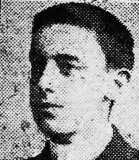
Gilbert Charles Reynolds, Corporal, 200415, South Wales Borderers. Gilbert was born in 1897, the son of Malcolm Reynolds and Alice Annie Reynolds (nee Reece), of Cooper’s Hall, Cusop. He enlisted at Hay into the Brecknockshire Battalion, South Wales Borderers soon after the outbreak of war. The battalion was attached to the Welsh Division and moved to Pembroke Dock upon mobilisation. It was then withdrawn from the Division and on 29 October 1914 sailed from Southampton for Bombay, where the battalion transhipped and sailed for Aden, arriving on 16 December 1914. The climate in Aden was fearsome, with scorching heat during the day, and with little to do, the men spent much of their free time playing football. By June 1915 the Turks had become overconfident due to the lack of any incursions by the British into Yemen and moved forward to reoccupy fortifications at Sheikh Saad. They then began to shell the island of Perim, so the Allied troops in Aden were mobilised into the Aden Movable Company and ordered to prepare to join with local troops. 400 men of the Brecknocks were allocated to the column, the remainder stayed in Aden. A small artillery column was built up to join it and on 3 July the force moved out to Sheikh Othman. Many men collapsed on the march, which was carried out during the full heat of the day, but by 7.30 pm the column had completed its six-mile advance. Thirteen men died of heatstroke during the following day, 4 July 1915, during an even longer march. In August 1915 the battalion moved to India on garrison duties, where it remained for the duration of the war. Gilbert took ill just weeks prior to the Armistice and died of pneumonia at Mhow on 27 October 1918. The 21-year-old was buried in Mhow New Cemetery, India.
Sydney Roberts, Lance Corporal, 8725, Lincolnshire Regiment. Sydney was born in Greenwich in 1882, probably the illegitimate son of George Roberts and Frederica Smith. He was raised by Millicent Harrison at 2, Douglas Road, Willesden, then left home as a young man and enlisted into the Grenadier Guards in January 1897. Sydney served with the Grenadiers for the next twelve years, spending a year in Gibraltar until October 1898, then spent the rest of his service at Home. Upon leaving the Grenadier Guards in February 1909, he re-enlisted into the Lincolnshire Regiment just days later and was posted to Portsmouth, where he met, then married, Catherine Williams, the daughter of Charles and Mary Williams, of Cusop, on 14 August 1910. The couple set up home at 14, Gold Street, Southsea, where their three children were born over the coming years. Following the outbreak of war, Sydney embarked for France with the 1st Battalion, Lincolnshire Regiment on 13 August and landed at Le Havre the following day. The battalion was attached to 9 Brigade, 3rd Division and entrained for the Belgian frontier town of Mons. One of the first Divisions to move to France, the 3rd Division fought during the opening Battle of Mons on 23 August 1914, and in the epic retreat, from the Rearguard Action of Solesmes, through the Battle of Le Cateau, and down to the Marne, where the German Offensive was stopped. Sydney was wounded during the Battle of the Marne, suffering shrapnel wounds to his left forearm and was evacuated back to Britain to the 3rd Northern General Hospital at Sheffield, for treatment. He died of his wounds there after contracting tetanus, on 28 October 1914. The 32-year-old was buried in Burnsgreave Cemetery, Sheffield. Sydney never lived at Hay, but following his death, his widow Catherine moved back there with her three children and settled at Bridge Street, Hay. She died at Hay on 18 February 1955, after having never remarried. Sydney is not commemorated on the Hay and Cusop war memorial.
Walter James Sheppard, Private, 67866, South Wales Borderers. Walter was born in Lahore, India on 31 August 1900, the son of Amos Sheppard and Esther Lydia Sheppard (nee Webb). His father died when Walter was still a child and his mother remarried to Frank Herbert Ridgway, a soldier serving in India with the South Wales Borderers, on 2 August 1909. When the 1st Battalion, South Wales Borderers returned to England in 1910, the family came back with Frank, and by 1911 were residing at the Barracks in Chatham, where the battalion was stationed. Frank was by now a Colour Sergeant with the battalion and was given the post as drill instructor with the Brecknockshire Battalion, South Wales Borderers, moving with his family to Brook Cottage, Oxford Road, Hay. Young Walter then began work for T. J. Stoke, Grocer, at High Town, Hay. He enlisted into the South Wales Borderers on his eighteenth birthday, on 31 August 1918, and was posted to Kinmel Park to join the 53rd (Graduated) Battalion, South Wales Borderers. Sadly, Walter had only been at Kinmel three weeks when he contracted pneumonia and was sent to hospital at Kinmel Park, where he died on 30 September 1918. The 18-year-old was buried with full military honours in St. Margaret’s Churchyard, Bodelwyddan four days later.
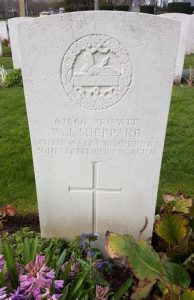
Fred Hugh John Stephens, Staff Sergeant, 200512, South Wales Borderers. Fred was born in 1880, the son of Alfred Henry Stephens and Isabella Thirza Stephens (nee Williams), of The Sheephouse, Hay. His father died in 1888 and his mother remarried to Arthur Jones in 1893. Fred trained as a carpenter and in 1901 left home to work in Bedwellty, marrying Elizabeth Ada Jones there in 1902. By 1911 Fred was living back with his mother, who had been widowed again, at the Nelson Inn, Hay. Fred was serving with the Brecknockshire Battalion, South Wales Borderers when war erupted. The battalion was attached to the Welsh Division and moved to Pembroke Dock upon mobilisation. It was then withdrawn from the Division and on 29 October 1914 sailed from Southampton for Bombay, where the battalion transhipped and sailed for Aden, arriving on 16 December 1914. The climate in Aden was fearsome, with scorching heat during the day, and with little to do, the men spent much of their free time playing football. By June 1915 the Turks had become overconfident due to the lack of any incursions by the British into Yemen and moved forward to reoccupy fortifications at Sheikh Saad. They then began to shell the island of Perim, so the Allied troops in Aden were mobilised into the Aden Movable Company and ordered to prepare to join with local troops. 400 men of the Brecknocks were allocated to the column, the remainder stayed in Aden. A small artillery column was built up to join it and on 3 July the force moved out to Sheikh Othman. Many men collapsed on the march, which was carried out during the full heat of the day, but by 7.30 pm the column had completed its six-mile advance. Some thirteen men died of heatstroke during the following day, 4 July 1915, during an even longer march. In August 1915 the battalion moved to India on garrison duties, where it remained for the duration of the war. Fred survived the war, but sadly contracted influenza whilst sailing through the Suez Canal, whilst the Brecknocks were making their way back to Britain and died in Egypt on 2 April 1919. The 38-year-old is buried in Suez War Memorial Cemetery, Egypt. His stepbrother, Charles Thomas Roger Jones, had been killed in France in 1918, whilst a nephew, Kenneth George Charles Davies, was killed in North Africa in 1942.
Frank Tong, Trooper, 384, Australian Light Horse. Frank was born on 23 November 1891, the son of Charles Tong and Eliza Theresa Tong (nee Stringer), of 10, Duke Street, Kington. The family moved to Victoria Terrace, Cusop by 1911, before moving again to Bridgend Cottage, Hay, where Frank began work as a gamekeeper for Captain Kidston of Gwernyfed. Frank emigrated to Australia just after his 21st birthday and found work as a labourer at Liverpool, New South Wales. Frank enlisted at Liverpool into the 4th Light Horse Regiment on 26 October 1914 and was posted to B Squadron. The 5th Light Horse Regiment had been raised in Brisbane in September 1914 and became part of the 2nd Light Horse Brigade. The Brigade embarked from Sydney, New South Wales, aboard HMAT A34 Persic on 21 December 1914, and disembarked in Egypt on 1 February 1915. The Australians then began training in the desert around Mena Camp, in the shadows of the great pyramids, initially thinking that they were to be deployed to France. In the meantime, the Admiralty, at the behest of Winston Churchill, began planning to launch an assault to capture the Dardanelles Straits, so that a naval force could enter the Black Sea and bombard Constantinople, to force Turkey out of the war, so the Australians were kept in Egypt. The initial landings on the Gallipoli peninsula began on 25 April 1915, the Australians landing at Anzac Cove, but soon became bogged down after a failure to break the Turkish defences. The light horse, initially considered unsuitable for operations at Gallipoli, were subsequently deployed without their horses to reinforce the infantry and landed at Anzac Cove in late May 1915 to reinforce the severely depleted 1st Australian Division. On 28 June, the Army Corps Headquarters at Anzac Cove received orders to create a diversionary attack at Anzac in order to divert attention away from a British attack at Cape Helles upon a portion of the Achi Baba position. The 5th Light Horse Regiment, two troops of the 7th Light Horse Regiment and two companies of the 9th Battalion, supported by the 11th Battalion of the 3rd Infantry Brigade, advanced on the right and attacked the Turkish trenches towards Gaba Tepe and towards the lower ridges of the Lone Pine position that day. Frank was killed in action during the fighting that day, 28 June 1915, while the 5th Light Horse was advancing along Harris Ridge. The 24-year-old is buried in Shell Green Cemetery, Gallipoli.
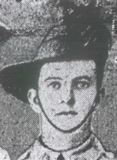
Charles Rawlings Walker, Lance Corporal, 20341, Worcestershire Regiment. Charles was born in New York, USA in 1898, the son of Alfred Henry Walker and Ellen Walker (nee Knott). His father was the son of Reverend Thomas James Walker and Mary Walker, of 2, Church Street, Hay, and his mother, Ellen, was from Tenbury. The family came back to Britain in 1899, initially moving in with Ellen’s parents in Tenbury, before moving to Cardiff by 1901. Charles worked for his grandparents at The Haggetts, Rochford, Tenbury, Worcester prior to the war and was a regular visitor to his widowed grandmother, Mary, at Hay, until her death in 1911. By then his parents had moved to 7, Penmaen Terrace, Swansea. Charles enlisted at Tenbury into the Worcestershire Yeomanry soon after the outbreak of war. He was drafted to France in the spring of 1916, joining the 1/8th Battalion, Worcestershire Regiment, which was attached to 144 Brigade, 48th (South Midland) Division. The division saw its first major engagement at the opening of the Battle of the Somme, holding the line between the 56th (London) and the 31st Divisions, both of which were heavily engaged at Gommecourt and Serre respectively. Two of the battalions of the Division attacked on 1 July 1916 and suffered heavy casualties. The division then went into action at the Battle of Bazentin, during the second phase of the Battle of the Somme and captured the village of Ovillers. After a brief period out of the line rebuilding, the division moved back into the line and took part in the Battle of Pozieres. The division was relieved at the beginning of September and moved to the Mondicourt area to rebuild again, before returning to the front by 15 October, taking over the Hébuterne sector. The division then moved to positions at Le Sars at the beginning of November to take part in the Battle of the Ancre. Charles was wounded during this period in the line and was evacuated to the Casualty Clearing Station at Dernancourt, where he died of his wounds on 8 November 1916. The 18-year-old is buried in Dernancourt Communal Cemetery Extension, France. Charles is not commemorated on the Hay and Cusop war memorial. One of his brothers, Joseph Edgar Knott Walker, died whilst on active service during the Second World War.
William Martin Watkins, Second Lieutenant, Royal Air Force. William was born in 1892, the son of David Watkins and Elizabeth Watkins, of The Priory Farm, Clifford. He worked on his parent’s farm prior to the war, and was a member of the Montgomeryshire Yeomanry, having enlisted in 1911. By the time war erupted, William had risen to the rank of Sergeant. On 5 August 1914 the Montgomeryshire Yeomanry was mobilised at Welshpool, as part of the South Wales Mounted Brigade, before moving via Hereford to Thetford, to join the 1st Mounted Division. On 4 March 1916 the 1st Mounted Division sailed for Egypt to join the EEF. William served in Egypt until December 1916, when he returned to England to take up a commission and was posted to the Cambridge Officer Training Corps. In May 1917 he came home on leave, then in August 1917 was commissioned as Second Lieutenant into the 3rd Battalion, Welsh Regiment. William was then drafted out to France, where he was severely wounded in the knee, thigh and back, and was nursed back to health at the War Hospital at Edinburgh. He came home on leave again in March 1918 after transferring to the Royal Flying Corps and after completing his training as an observer, came home on leave again in June 1918, before being posted to Italy to join 139 Squadron, Royal Air Force. The squadron was formed on 3 July 1918 at Villaverla in Italy and was equipped with Bristol F2b fighter aircraft. On 23 July 1918 William took off from Villaverla aboard an F2b piloted by an eccentric American, Lieutenant Van Dyke Fernald, on an offensive patrol. Their fellow aircraft returned to base after having one aircraft shot down, but Fernald and William remained over enemy lines. Their fate is unknown, but they crashed behind enemy lines north of the Piave River that day, William being killed instantly, and Fernald dying of his wounds shortly after. William was 26 years old when he died during the crash. He and his pilot were buried with military honours at San Fior di Sopra, North of Conegliano. Both men’s graves were exhumed after the war and they were re-interred in Tezze British cemetery, Italy.
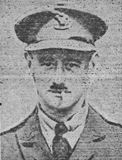
Thomas Fitch Wellings, Lieutenant, Royal Garrison Artillery. Thomas was born in 1885, the son of Thomas Wellings and Janette Wellings (nee Harris), of 12, St. Donatts Road, Greenwich, London. Thomas worked as a shipping clerk for Stevenson Clarke & Co, in London. He married Edith Pilkington Rocke in 1909 and the couple initially resided at 59, Sydenham Road, Sydenham. Just prior to the war the couple had moved to 89, Electric Avenue, Westcliff-on-Sea, whilst Thomas’s mother, by now widowed, had moved to Castle Street, Hay. Thomas enlisted into the Officer Cadets in 1916 and on 5 April 1917 was commissioned as Second Lieutenant into the Royal Garrison Artillery. He was posted to France with the 297th Siege Battery, Royal Garrison Artillery and saw his first action in the Ypres Salient, where the battery supported the Allied offensive upon Passchendaele Ridge from 31 July 1917. During July 1918 the battery was in the Arras sector. Thomas had volunteered to transfer an anti-aircraft gun section and was preparing to go on leave when he was wounded. He was evacuated to a hospital at Aubigny-en-Artois, where he died of his wounds on 16 July 1918. The 33-year-old was buried in Aubigny Communal Cemetery Extension, France. Thomas is not commemorated on the Hay and Cusop war memorial.
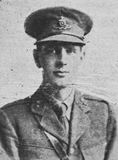
George Williams, Private, 14684, King’s Shropshire Light Infantry. George was born on 19 March 1894, the son of Thomas and Elizabeth Williams, of 47, Lion Street, Hay. He had worked as a Groom with Mr. Lewis, of Llys Newydd, Cilycwm, Carmarthenshire prior to the war and enlisted in September 1914 into the 7th Battalion, King’s Shropshire Light Infantry. The battalion was attached to 76 Brigade, 25th Division, and moved to France on 28 September 1915. The division made its way across northern France, and took up positions near Ploegsteert Wood, in Belgium. It then spent a period in trenches around Sanctuary Wood, east of Ypres, before enjoying a spell of training out of the line at Steenvoorde. The division took up new positions at The Bluff, east of Ypres, in November, before moving again to Northern France, taking over the St. Eloi sector. George was killed in action here on 3 December 1915, whilst attempting to rescue a wounded comrade from No Man’s Land. The 21-year-old was originally buried behind the lines, but after the war his grave was found and exhumed and he was re-interred in Y Farm Military Cemetery, Bois-Grenier, France.
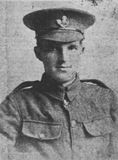
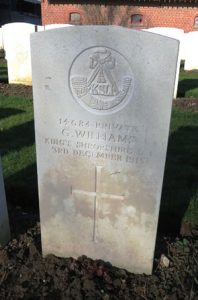
John Christopher Arthur Williams-Vaughan, Second Lieutenant, South Wales Borderers. John was born on 23 July 1891, the son of John Williams-Vaughan and Elizabeth Bertha Williams-Vaughan (nee Harris), of Penymaes, Hay. He was educated at Eton and at Hertford College, Oxford, where he graduated in science with honours in 1914. John rowed for Hertford College for three years and was captain of the college boat club in 1913. He broke his leg just prior to the outbreak of war and was not deemed fit enough to enlist until April 1915, when he was commissioned as Second Lieutenant into the 3/1st Brecknockshire Battalion, South Wales Borderers, joining the battalion at Milford Haven. John embarked for France on 4 June 1916 and was posted to the 100th Company, Machine Gun Corps. The company was at Cuinchy, attached to 100 Brigade, 33rd Division. On 22 June 1916 the Germans exploded a massive mine beneath the position held by one of the divisions units, B Company, 2nd RWF, which killed 54 men of the battalion, as well as trapping a number of British tunnellers underground. During the attempted rescue of one tunneller, a soldier of the 14th Welsh, Sapper Hackett was awarded the VC. At the beginning of June, the 33rd Division moved out of the sector and began to move into the Somme area. The 100th Company moved to positions near Fricourt, which had been recently captured, and set up gun positions overlooking Trônes Wood and Montauban. On 14, July John took A Section of the company forward in support of the 1st Queen’s, who were to attack High Wood. As the men of the 1st Queen’s launched their assault, John led his men forward, setting up their guns to cover the attack, remaining in position under heavy fire at the edge of High Wood for over two hours. He was badly wounded by shell fragments whilst in the process of moving his men later in the day but remained at duty until being killed at around 08.30 that morning. The 25-year-old has no known grave and is commemorated on the Thiepval Memorial, France.
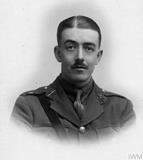
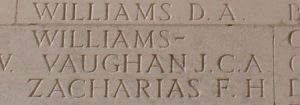
George Samuel Woonton, Sergeant, 70059, Canadian Infantry. George was born on 1 May 1891, the son of George Samuel Joseph Woonton and Miriam Woonton (nee Robinson), of Bailiwick, Jersey. The family moved from Jersey to London by 1901, and George’s father was working as a carpenter. George worked as a butler’s assistant at the Junior Carlton Club at 30-35 Pall Mall, London as a young man. The club was an exclusive members club for Conservative Party members. George then decided to emigrate to Canada to start a new life, so embarked aboard the SS Corsican for Quebec on 26 July 1912, and found work as a tender fitter at St. John, New Brunswick. By now his father had gained a position as gardener to Miss V. de Winton, and had moved with his wife to Laurel Cottage, Hay. George enlisted at St. John into the Canadian Expeditionary Force on 20 November 1914 and was posted to the 26th Battalion, Canadian Infantry (New Brunswick Regiment). The battalion embarked for Britain on 15 June 1915 and after disembarking at Devonport moved to a camp at East Sandling, to continue its training, as part of the 5th Canadian Infantry Brigade, 2nd Canadian Division. George was then granted leave and visited his parents at Hay for the first and last time. On 15 September the 26th Battalion moved from camp to embark at Folkestone, disembarking at Boulogne that day before spending the night at Ostrohove Rest Camp. On the following morning the battalion entrained for Wizernes then marched to billets near Hazebrouck. The battalion moved to a camp on the Scherpenberg soon afterwards, before the 2nd Canadian Division took over its own sector of the front line by the end of the month and its infantry battalions began the usual routines of rotating in the trenches, usually four days in the front line, four in support and four in reserve. George was operating a West Bomb Throwing engine, a contraption similar to a catapult, on 10 October 1915 when it accidentally sprang and dropped a grenade in his trench. He was instantly killed by the blast of the grenade. The 24-year-old was buried by his comrades in La Laiterie Military Cemetery, Belgium.
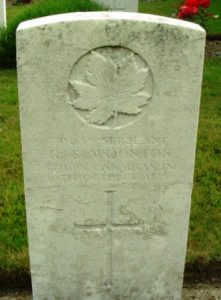
World War Two, 1939-1945
Roger John Gilbert Burney, Sub-Lieutenant, Royal Naval Volunteer Reserve. Roger was born in Hampshire on 25 March 1919, the son of Lieutenant-Colonel Arthur Edward Cave Burney, DSO, MC, and of Dorothy Burney (nee Norton). His father was a serving officer with the Royal Artillery, and his parents owned Oakfield, Hay, the family home. Roger was educated at Cambridge, graduating BA before enlisting into the Royal Naval Volunteer Reserve. In January 1942, Roger, together with another three Royal Navy officers, were posted aboard the Free French submarine Surcouf. The French had decided to send the submarine to the Pacific theatre, after she had been re-supplied at the Royal Naval Dockyard in Bermuda. Her move was shrouded in secrecy, with rumours abounding that Surcouf was going to liberate Martinique from the Vichy regime, however the submarine was bound for Sydney, Australia, via Tahiti. She departed Halifax, Nova Scotia for Bermuda on 2 February for Bermuda, then departed Bermuda on 12 February for the Panama Canal. The Surcouf vanished on the night of 18/19 February 1942, about seventy miles north of Cristóbal, Panama, while en route for Tahiti, via the Panama Canal. She was possibly sunk after being hit by the American freighter Thompson Lykes, which later reported hitting a partially submerged craft. Roger was 22 years old when he was lost aboard Surcouf that night, and is commemorated on the Portsmouth Naval Memorial, Hampshire. His brother, Christopher Arthur Geoffrey Burney was an agent for the Special Operations Executive (SOE) in France, who was captured by the Germans and survived incarceration at Buchenwald.
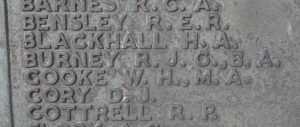
Kenneth George Charles Davies, Flying Officer, 44522, Royal Air Force. Kenneth was born on 7 May 1918, the son of George Rowland Davies and Alice Susan Davies (nee Stephens), of Llowes Court, Llowes. His mother was from Hay, and his parents had married there on 21 April 1914. Kenneth was a Welsh international rugby player at schoolboy level. He enlisted into the Royal Artillery in 1939, before being granted a commission into the Royal Air Force on 7 September 1941. He trained as a fighter pilot before being posted to 208 Squadron, Royal Air Force, which was based at RAF Sidi Azeiz, Libya, under the command of the Western Desert Air Headquarters. The squadron flew Westland Lysander reconnaissance aircraft and Hawker Hurricane fighters on army co-operation duties in the North African Campaign and the Greek Campaign of 1941. Kenneth crash landed Hurricane Z4085 on 2 February 1942 after being attacked by two ME109’s and hit in the oil tank. He was unhurt, but the damage to his Hurricane meant that when he went out on his next patrol on 9 February 1942, he was flying Hurricane Mark I, Serial V7836. Kenneth had just completed a strafing run on Martuba Airfield when he was attacked and shot down by a German Messerschmitt Bf109 and crashed. The 23-year-old was killed during the crash. No trace of him was ever found, so he is commemorated on the Alamein Memorial, Egypt. Kenneth is commemorated on the war memorial in St Mary’s Church, Hay, but not on the Hay and Cusop war memorial. He is also commemorated on the Llandrindod Wells County School war memorial. Two of his uncles fell during the Great War: Charles Thomas Roger Jones; and Fred Hugh John Stephens.
Lancelot Steele Dixon, Pilot Officer, 77348, Royal Air Force. Lancelot was born in London in 1915, the son of Hugh Wainwright Dixon and Christina Dixon (nee Wood). His father was a wealthy merchant, and his mother a renowned artist and sculptor. They divorced while Lancelot was still in school, and his mother remarried to the famous author Rafael Sabatini, who himself had been previously married to Hugh Dixon’s sister. The couple then moved to the Clock Mill, at Clifford, Herefordshire. Upon leaving school, Lancelot enlisted into the Royal Air Force and was accepted for pilot training. He was posted to 5 Operational Training Unit (OUT), which was based at RAF Aston Down, in Gloucestershire, and began learning to fly. On 9 April 1940, Lancelot was flying a North American Harvard I trainer on a training flight, when he decided to fly over his mother house at Clifford. Unfortunately, his plane lost control and spun into the ground at Winforton, six miles south of Kington, killing Lancelot instantly. The 23-year-old was buried in Hay Cemetery and his grave is marked with a sculpture of the figure of Icarus, carved by his mother. He is not commemorated on the Hay and Cusop war memorial.
David Evans, Corporal. David cannot presently be identified.
Percival James Samuel Evans, Flying Officer, 49888, Royal Air Force. Percival was born in 1919, the son of Percival Charles Evans and Frances Elizabeth Evans (nee Hammond), of 4, Sackville Cottages, Hay. He enlisted into the Royal Air Force and after completing his training as a Navigator was posted to 605 Squadron, Royal Air Force, a Fighter Command unit based at RAF Castle Camps, in Cambridgeshire. The original squadron was lost in Singapore, so a new 605 squadron was formed at RAF Ford on 7 June 1942, equipped with Douglas Boston and Havocs in the intruder role. These were replaced with de Havilland Mosquitoes from February 1943. On the night of 2 August 1943, Percival took off from Castle Camps aboard a Mosquito Fbvi, Serial HJ782, on an intruder sortie to northwest Germany. During the early hours of 3 August 1942, the Mosquito was intercepted and shot down by a German night fighter, crashing into the Wadden Sea south of Westerland, Schleswig-Holstein and killing both Percival and his pilot, Albert Aylott. 23-year-old Percival has no known grave so is commemorated on the Runnymede Memorial, Surrey.
John Hawkesford Hinckes, Second Lieutenant, 79908, Royal Sussex Regiment. John was born in Hay in 1910, the son of Doctor Thomas Ernest Hincks and Laura Louise Stewart Hincks (nee Paterson), of Oxford Road, Hay. His father and his grandfather had run their own medical practise in Hay for many years. John was educated at Bromsgrove School, but when his father retired, the family moved to Bexhill-on-Sea, Sussex. John was commissioned as Second Lieutenant into the Royal Sussex Regiment prior to the outbreak of war and embarked for France with the 5th Cinque Ports Battalion, as part of the BEF, on 8 April 1940 on board the SS Amsterdam. The battalion moved on to Vivoin, then to Belleuse, before marching to St. Pol, with the HQ being set up at Conteville, on the Somme. When the German offensive in the west opened on 10 May, the BEF advanced into Belgium and on 11 May the 5th Sussex went to Lillers on Line of Communication duties. It then moved on to Vichtrat Peteghem to take up defensive duties, but upon arriving there was sent back into France as the Germans had broken through. On 20 May the 5th Sussex went to Wortegem to take up defensive positions covering the River Escaut and almost immediately came under shell and mortar fire. Heavy fighting raged over the coming days, as the Escaut line was stubbornly held as other elements of the BEF withdrew towards Dunkirk. John was killed at sometime between 27 May 1940 and 29 May 1940, during fighting around Strazeele. The 29-year-old is buried in Caestre Communal Cemetery, France. His brother Thomas died in Ceylon in 1943, whilst their uncle, Bertram Hincks, was killed in the Great War. John and his brother Thomas are not commemorated on the main Hay and Cusop war memorial but are commemorated on a memorial plaque inside St. Mary’s Church.
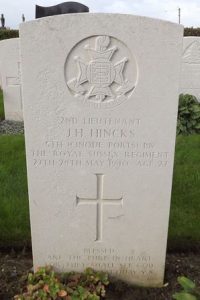
Thomas Stuart Hincks, Lieutenant, Ceylon Pioneers. Thomas was born in Hay in 1907, the son of Doctor Thomas Ernest Hincks and Laura Louise Stewart Hincks (nee Paterson), of Oxford Road, Hay. His father and his grandfather had run their own medical practise in Hay for many years. John was educated at Bromsgrove School, but when his father retired, the family moved to Bexhill-on-Sea, Sussex. Thomas married Sheila Biron at Herstmonceux, Sussex, on 3 October 1936 and the couple moved to Ceylon to the tea plantation at Chrystlers Farm, Kotagala, where he was plantation manager. Thomas gained a commission as Second Lieutenant on 3 April 1942, being placed on the General List, and was posted to the Ceylon Auxiliary Pioneer Battalion, Ceylon Engineers. He died in Ceylon on 2 November 1943. The 35-year-old is buried in Trincomalee War Cemetery, Sri Lanka. His brother, John, was killed in France in 1940, whilst their uncle, Bertram Hincks, was killed in the Great War. Thomas and his brother John are not commemorated on the main Hay and Cusop war memorial but are commemorated on a memorial plaque inside St. Mary’s Church.
John Howard, Private. John cannot presently be identified.
Ernest Jenkins, Corporal, 3054179, The Royal Scots. Ernest was born on 26 April 1915, the son of Albert Jenkins and Emily Jenkins (nee Williams), of 3, Garibaldi Terrace, Hay. He enlisted in the army soon after the outbreak of war and was posted to Hong Kong to join the 2nd Battalion, The Royal Scots. With growing concerns about security in the Pacific, the 2nd Royal Scots moved into defensive positions around Hong Kong. The Battle of Hong Kong began on 8 December 1941, just a few hours after the attack on Pearl Harbour, and after weeks of bitter fighting, the garrison surrendered on Christmas Day. Ernest was taken into captivity with the rest of the survivors of the battalion. After months in captivity, in September 1942, Ernest was among some 1,816 British and Canadian POWs herded aboard the Japanese Hellship, Lisbon Maru, together with some 700 Japanese service personnel and were put into the ships holds, in atrocious conditions. The ship sailed on 27 September en route for Japan via Shanghai, and many of the men were already suffering from ill-health. On 1 October 1942, the ship was torpedoed by the submarine USS Grouper. The Japanese troops were evacuated from the ship, but the POWs were left aboard, the ships hatches being battened down above them, and they were left on the listing ship. Some of the POW’s managed to break through the hatch covers and managed to escape before it sank but were machine-gunned in the water. Ernest was 27 years old when he was killed during the sinking of Lisbon Maru that day. He has no known grave so is commemorated on the Sai Wan Memorial, Hong Kong.
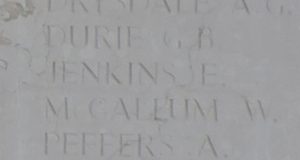
John Jenkins, Private, 14088773, Royal Army Ordnance Corps. John was born in 1927, the son of William Jenkins and Margaret Emily Jenkins (nee Williams), of 8, Oakland Villas, Hay. He enlisted into the Royal Army Ordnance Corps just prior to the end of the war and was posted overseas. John reportedly became poisoned by drinking contaminated water whilst returning home in June 1947 and died at Winchester on 10 June 1947. The body of the 20-year-old was brought home and he was buried in Hay Cemetery.
John Alex Carl Lehto, Private, 4079386, Monmouthshire Regiment. John was born in 1921, the son of John Alec Lehto and Florence May Lehto (nee Parry), of 11, Black Lion Green, Hay. He enlisted into the army and was posted to the 3rd Battalion, Monmouthshire Regiment. The battalion, a Territorial Army unit, was mobilised for war as part of the 53rd (Welsh) Division and moved to Northern Ireland to begin garrison duties. The Division then moved to Pembroke Dock, before moving again to the south of England, where it trained in readiness for the D-Day Landings. In the summer of 1942, the 3rd Monmouth’s transferred to the 11th Armoured Division and began training as a mechanised unit, equipped with Valentine and Crusader tanks. Most of the 11th Armoured Division landed on Juno Beach on 13 June 1944 and saw its first major action during Operation Epsom on 26 June, where it assisted the 15th (Scottish) Division alongside the 159th Brigade, which had been attached to it from the 53rd (Welsh) Division. John was killed during the ensuing Operation Goodwood on 18 July 1944. The 23-year-old was originally buried near Cuverville, but in August 1945 his grave was exhumed, and he was re-interred in Ranville War Cemetery, France. (The memorial states Peter Lehto).
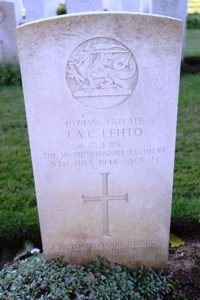
John Preece, Able Seaman. John cannot presently be identified.
Michael Charles Stapleton, Aircraftman 2nd Class, 1881651, Royal Air Force Volunteer Reserve. Michael was born on 23 March 1926, the son of Charles Stapleton and Alice Stapleton (nee Lane), of 2, Belmont Road, Hay. He enlisted into the Royal Air Force Volunteer Reserve as soon as he turned eighteen, and was posted to the Middle East, to RAF Habbaniya, which was an important staging point for travel to and from Britain to Russia, so was kept operational after the end of the war. Michael was killed at Habbaniya on 4 April 1946, reportedly of a gunshot wound to the head. The 20-year-old was buried in Habbaniya War Cemetery, Iraq.
Ernest William Turner, Lance Corporal, 4199604, Royal Welch Fusiliers. Ernest was born at Hay in 1910, the son of Lilian Agnes Turner. His mother married the widowed Arthur Samuel Bedford in 1914, and Ernest was raised as his son. Ernest enlisted into the army and was posted to the 6th Battalion, Royal Welch Fusiliers, a Territorial Army unit which was attached to 158 Brigade, 53rd (Welsh) Division. The battalion was mobilised at the outbreak of war, when the Division moved to Northern Ireland to begin garrison duties. The Division then moved to Pembroke Dock, before moving again to the south of England, where it trained in readiness for the D-Day Landings. On 24 June 1944 the 7th RWF left England for Normandy, and landed at La Riviere near Ver Sur Mer. The Division then took part in heavy fighting over the coming weeks, as part of the effort to break-out of the Normandy beachhead, seeing heavy fighting at Évrecy. Ernest was killed in action whilst the 6th RWF were supporting an assault by the 7th RWF and 4th RWF at Évrecy on the evening of 17 July 1944. The 34-year-old was originally buried at Évrecy together with a large number of other men killed during the attack, but after the war their graves were exhumed and re-interred in Banneville-La-Campagne War Cemetery, France. His half-brother, Hubert Arthur Moore, of Talgarth, was killed in Normandy on 30 June 1944.
Joseph Edgar Knott Walker, Private, 14271122, Royal Army Medical Corps. Joseph was born on 21 November 1900, the son of Alfred Henry Walker and Ellen Walker (nee Knott). His father was the son of Reverend Thomas James Walker and Mary Walker, of 2, Church Street, Hay, and his mother, Ellen, was from Tenbury. The family came back to Britain in 1899, initially moving in with Ellen’s parents in Tenbury, before moving to Cardiff by 1901. Joseph worked as a milkman and married Florence Elizabeth Symonds at Swansea in 1931. He enlisted into the Royal Army Medical Corps soon after the outbreak of war. Joseph died at Swansea on 18 December 1942. The 42-year-old was buried in St. Hilary’s Churchyard, Killay, Swansea. An elder brother, Charles Rawlings Walker, was killed during the Great War.
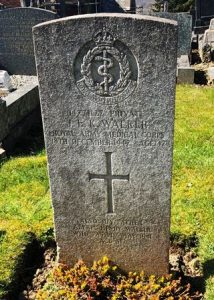
Glyndwr Williams, Leading Aircraftman, 412301, Royal Air Force Volunteer Reserve. Glyndwr was born on 19 June 1926, the son of Police Constable Thomas Hugh Williams, and his wife Gertrude Emily Meline Williams (nee Bird), of Cusop Police Station. He enlisted into the Royal Air Force Volunteer Reserve after his eighteenth birthday and was posted to 205 Group HQ in Egypt. Glyndwr was knocked down by a petrol tanker whilst on duty at RAF Heliopolis, in Egypt on 10 March 1947 and died of his injuries in the ambulance whilst on his way to hospital. The 20-year-old is buried in Tel El Kebir War Memorial Cemetery, Egypt.
John Williams, Stoker. John cannot presently be identified.
Kenneth Alfred Williams, Private, 14756023, King’s Shropshire Light Infantry. Kenneth was born on 29 May 1925, the son of Alfred Allen Williams and Madeline Olive Williams (nee Canby), of 10, Market Street, Hay. He worked as a baker’s van driver prior to the war. Kenneth enlisted into the army after his eighteenth birthday and was posted to the 4th Battalion, King’s Shropshire Light Infantry. The battalion was a Territorial Army unit, which was originally attached to the 159th Infantry Brigade, 53rd (Welsh) Infantry Division., however, on 17 May 1942, the 4th KSLI, along with the brigade, were transferred to become the motorised infantry element of the 11th Armoured Division. The division spent many months training in readiness for the Normandy landings, before landing in June 1944 and joining the epic fight to break out of the Normandy Beach-Head. The division then took part in the advance through Northern France into Belgium and Holland over the coming months, before crossing the Rhine into Germany in February 1945. The 11th Armoured Division liberated the Bergen-Belsen concentration camp on 12 April, then reached the river Elbe near Lüneburg, on 18 April. Kenneth was killed on the following day, 19 April 1945, during one of the last actions of the war. The 19-year-old was originally buried at Sassendorf, but his grave was later exhumed, and he was re-interred in Becklingen War Cemetery, Germany.
